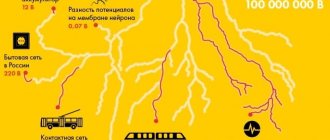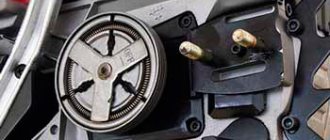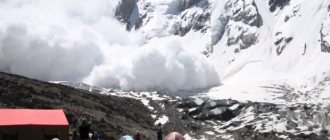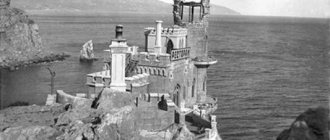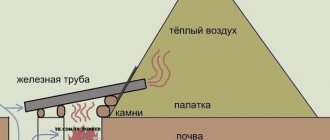Vietnamese traps for Americans
The article is written based on the books by Alan Lloyd Peter »Back. Part 1: Across the Fence" and "Back. Part 2: Into the Jungle."
During the Vietnam War (1964-1973), Americans faced one unexpected and very unpleasant surprise - a large number of Vietnamese traps. Due to the natural features of the area - dense jungle, many rivers and swamps, as well as an underdeveloped road network, the Americans could not fully use vehicles, and were forced to rely on helicopters in huge numbers to move troops. In the Vietnamese jungle itself, in the depths of the territory, American troops, having no other option, were forced to move and fight on foot. And this is in conditions of average summer temperatures of more than 30 degrees and one hundred percent humidity. It is also worth remembering what the rainy season is in Vietnam - when tropical rains fall almost continuously for several months, flooding vast areas with water. The main character of the film “Forrest Gump” talks about the rains in Vietnam: “One day it started to rain and did not stop for four months. During this time we learned about all types of rain: direct rain, slanting rain, horizontal rain, and even rain that comes from bottom to top.”
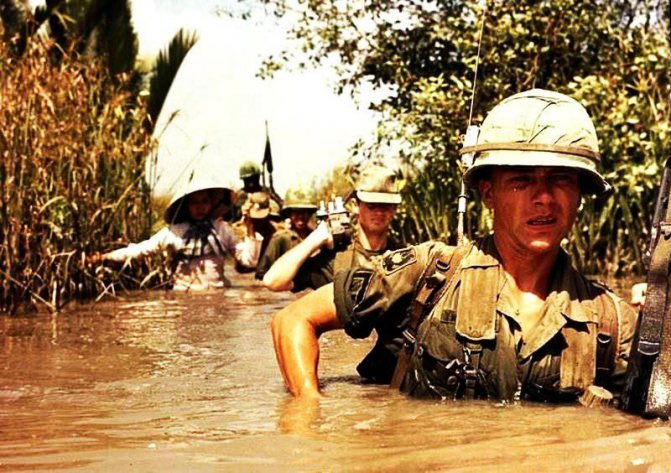
American Marines in murky Vietnamese waters

In the wilds of the Vietnamese jungle
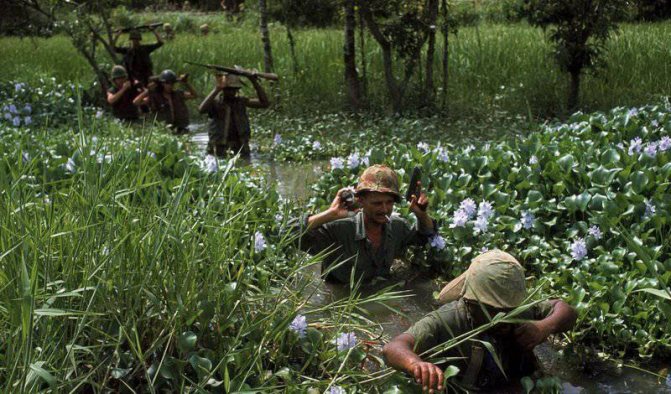
Vietnamese swamp. Batangan. 1965
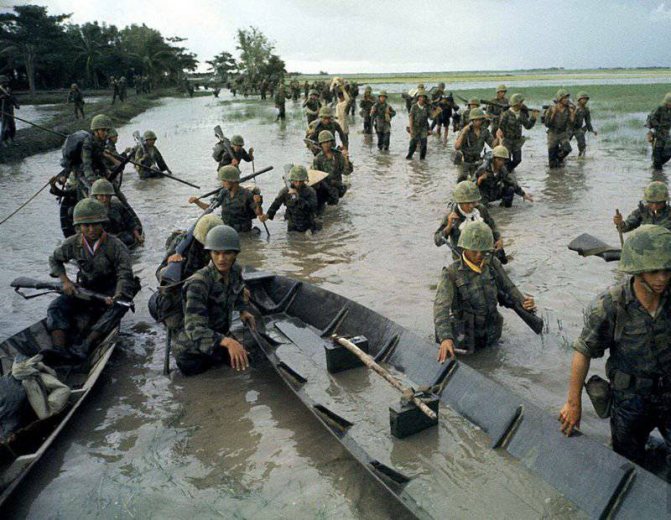
South Vietnamese Army soldiers on the march

A Piasecki H-21 Shawnee helicopter transports reinforcements and picks up the wounded. Vietnam. The beginning of the war. 1965
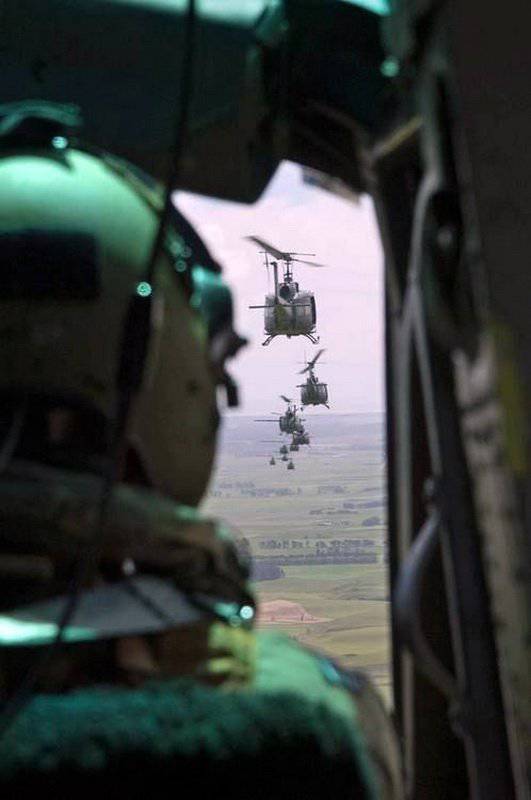
An aerial cavalcade of Bell UH-1 "Huey". 1968
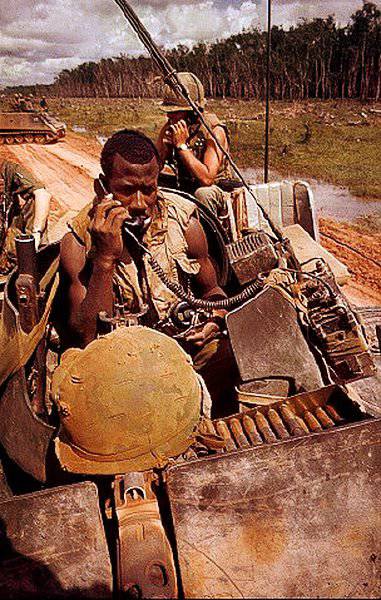
A column of the 25th Division on an M113 armored personnel carrier (APC) is moving along the “federal” road Tau Ninh-Dau Tieng. 1968

It was no better in the mountains of Vietnam. Shau District
In such specific conditions, when even a few dirt roads turn into an impassable mess, and the use of aviation is problematic, the technical superiority of the American army is to a certain extent leveled out and Vietnamese traps become very effective and deadly. Here are some of them.
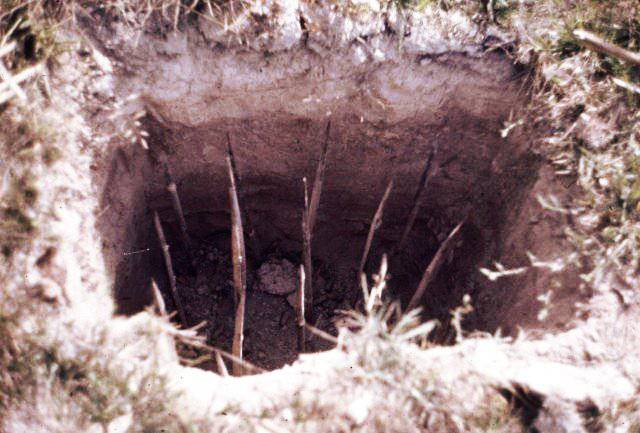
The famous Punji trap was installed in large numbers on forest paths, near American bases, and being camouflaged under a thin layer of grass, leaves, soil or water, it was difficult to detect. The size of the trap was calculated exactly to fit the foot in the boot. The stakes were always smeared with feces, carrion and other bad substances. Getting your foot into such a trap, having your sole pierced by stakes and being wounded almost certainly caused blood poisoning. They often had a more complex design.
Broken shoe
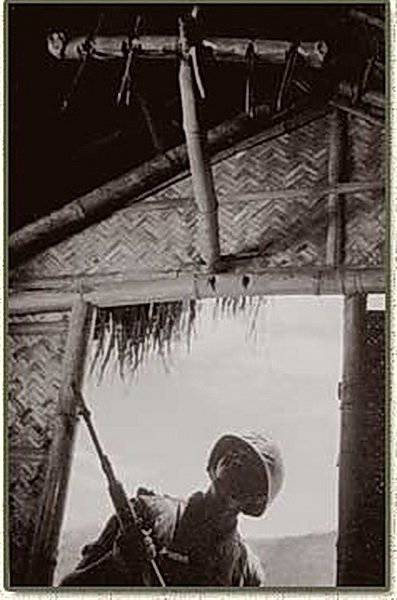
Bamboo trap - installed in the doors of rural houses. As soon as the door was opened, a small log with sharp stakes flew out of the opening. Often traps were set in such a way that the blow would fall on the head - if triggered successfully, this would lead to severe injuries, often fatal.
Sometimes such traps, but in the form of a large log with stakes and a trigger mechanism using a tripwire, were installed on paths in the jungle.
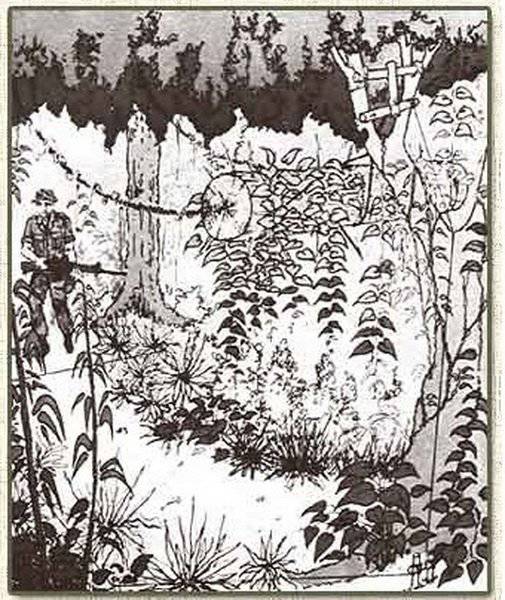
In dense thickets, the log was replaced with a spherical structure. It should be noted that the Vietnamese often made stakes not from metal, but from bamboo - a very hard material from which knives are made in Southeast Asia.
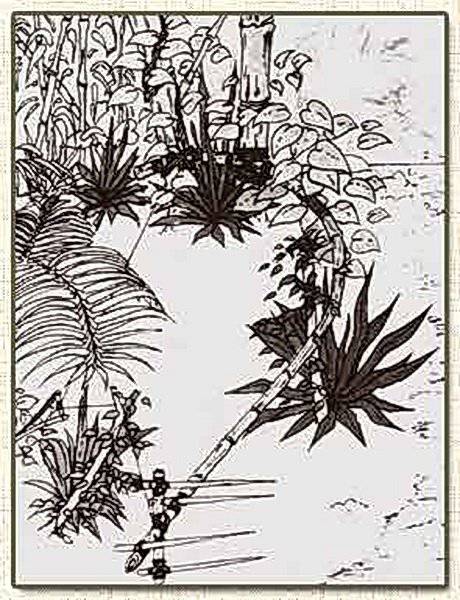
Whip Trap - often set along jungle trails. To do this, a bamboo trunk with long stakes at the ends was bent and connected to a guy wire through a block. As soon as you touched a wire or fishing line (the Vietnamese often used it), the released bamboo trunk with stakes hit with all its might the area from the knees to the stomach of the person who touched it. Naturally, all traps were carefully camouflaged.

Big Punji is a larger version of Punji. This trap inflicted much more serious injuries - here the leg was pierced up to the thigh, including the groin area, often with irreversible injuries in the area of the “main male organ”. The stakes were also smeared with something nasty.
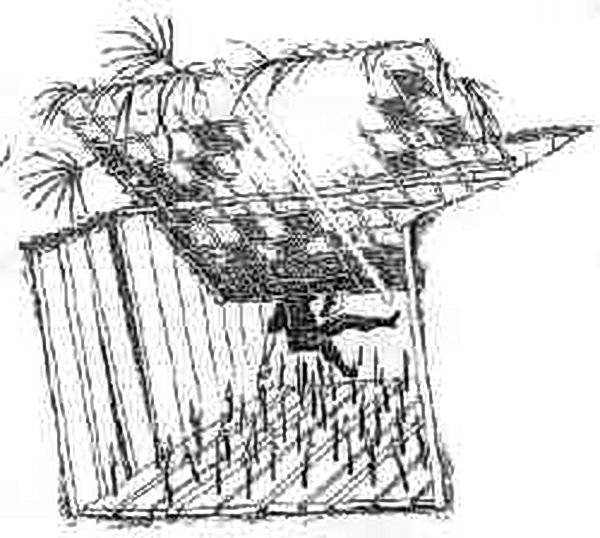
One of the scariest big Punjis is the one with the rotating lid. The lid was attached to a bamboo trunk and rotated freely, always returning to a strictly horizontal position. The lid was covered with grass and leaves on both sides. Having stepped on the platform lid, the victim fell into a deep hole (3 meters or more) with stakes, the lid was rotated 180 degrees and the trap was again ready for the next victim.
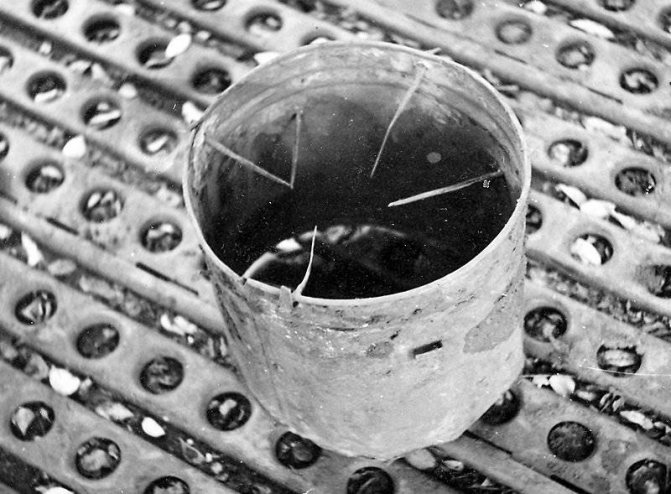
Bucket Trap (bucket trap) - a bucket with stakes, and often with large fishing hooks, dug into the ground, camouflaged. The whole horror of this trap was that the stakes were firmly attached to the bucket at an angle downwards, and if you fell into such a trap, it was impossible to pull out your leg - when you tried to pull it out of the bucket, the stakes only dug deeper into your leg. Therefore, it was necessary to dig out a bucket, and the unfortunate man, along with the bucket on his leg, was evacuated using MEDEVAC to the hospital.

Side Closing Trap - two boards with stakes were held together with elastic rubber, stretched, and thin bamboo sticks were inserted between them. As soon as you fell into such a trap, breaking the sticks, the doors slammed shut just at the level of the victim’s stomach. Additional stakes may also have been dug into the bottom of the pit.

Spike Board Trap - These traps were usually installed in shallow ponds, swamps, puddles, etc. As soon as you stepped on the pressure plate, the other end of the board with stakes would forcefully hit upward and towards the person who stepped on it. A successful hit often resulted in death. An example of such a trap being triggered from the film “Southern Hospitality”.
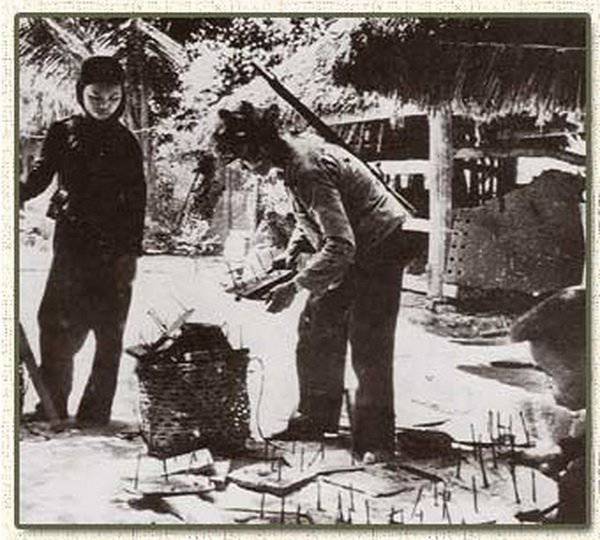
The Vietnamese have launched mass production of traps
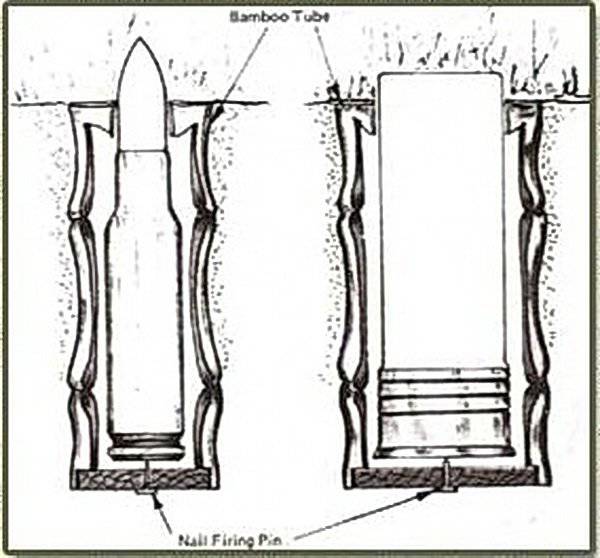
Press-action cartridge trap in a bamboo container. Various cartridges could be used, including hunting cartridges with shot or buckshot.
Although all these traps look impressive, of course, the damage they cause cannot be compared with mines and tripwire grenades. By constantly mining the territory and setting up tripwires, the Vietnamese managed to turn the presence of the American military on foreign soil into a real hell.
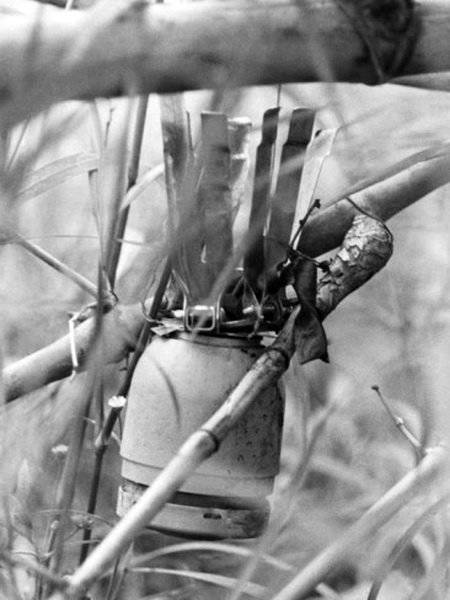
"Pineapple" - grenades, high-explosive shells and other ammunition suspended from tree branches. To trigger it, you had to touch the branches. One of the most common traps during the Vietnam War.
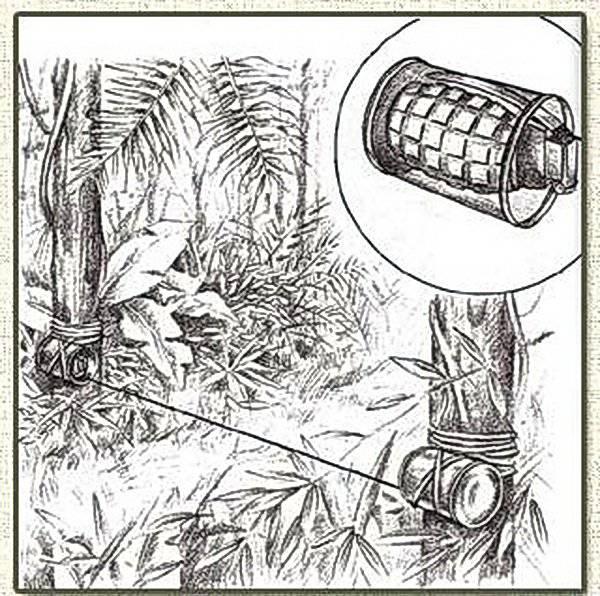
Stretching - installed on the ground or close to it. The situation was aggravated by the fact that in the forest floor of the jungle, in the twilight, it is very difficult to notice the trap, and even more so in forty-degree heat and one hundred percent humidity, which clearly do not contribute to concentration. The photo from Vietnam shows a well-installed tripwire with a Chinese hand grenade in the grass. Even with camera flash it is very difficult to notice.

Very often the Vietnamese installed tripwires underwater. It was almost impossible to detect them in muddy water.
Often, a vessel made of thick bamboo filled with a mixture of ammonia nitrate and diesel fuel was installed under a grenade or other ammunition. This technique greatly increased the damaging effect of a grenade explosion. So, on December 6, 1968, in the Ho Chi Minh Trail area, one such tripwire led to the death of 5 Marines and injuries of varying degrees of severity to another 12 from the group. The tripwire was the most common trap during the Vietnam War.
Naturally, as in any other big war, the Vietnamese massively used mines of various types - ordinary push-action, jumping, tripwire, directional, which were often set to non-removable, landmines along the roads to blow up vehicles and armored vehicles, as well as ambushes and sabotage behind enemy lines.
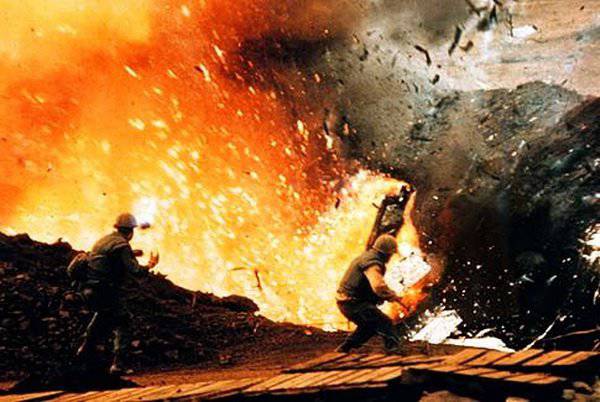
Good shot. An explosion of ammunition at a Marine base as a result of sabotage. Vietnam. March 18, 1968
To prevent their own people from falling into traps, the Vietnamese developed an entire signaling system of sticks, leaves and broken branches arranged in a certain way. An experienced person could use these marks to determine not only that a trap was installed nearby, but also the type of trap.
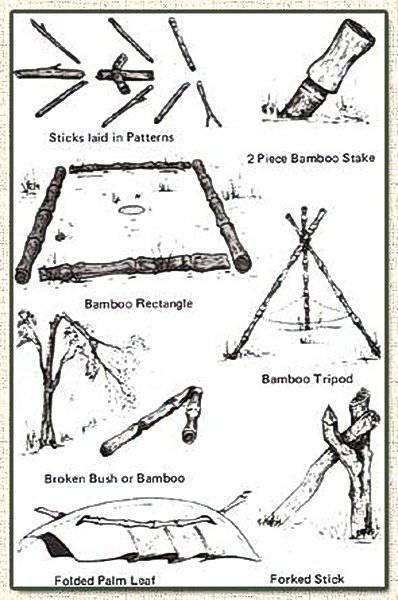
Trap signs
It is worth noting that the North Vietnamese showed amazing resilience, determination and fearlessness in this war. They skillfully used their modest resources, as well as the natural and climatic conditions of their homeland, inflicting the maximum possible damage on the enemy.

In the Vietnam War, the American army lost almost 60 thousand killed. Vietnam. September 16, 1966
This is not to say that the Americans did not struggle with this. The traps and signaling system were carefully and constantly studied. Regular training was conducted with personnel, and pocket instructions on traps and their disarming were issued. Miners began to be placed at the head of the groups.
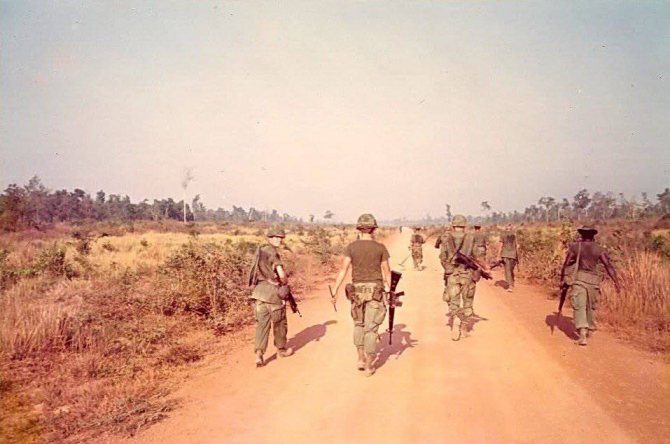
Miners at the head of the patrol. Vietnam. April 1972
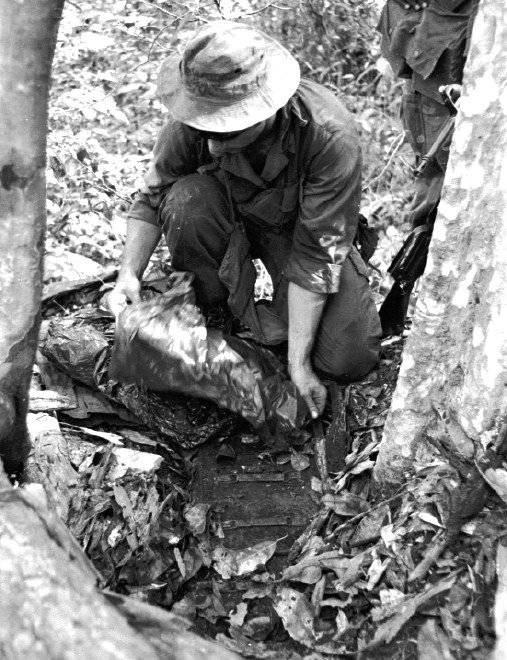
Disarming a trap
Rewards were paid to local residents for reports of found traps.
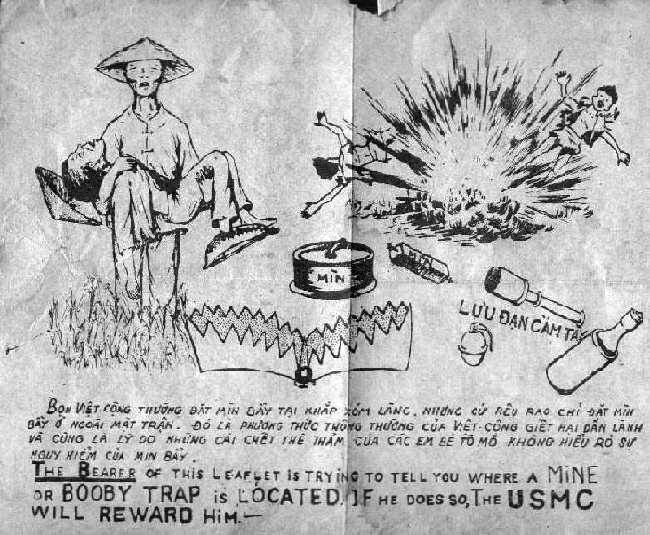
USMC announcement of reward for reporting decoys
However, the American military still continued to fall into traps and be blown up throughout the war.
Help on Tele2, tariffs, questions
Cu Chi is a rural area about 70 kilometers northwest of Saigon that has become a thorn in the side of first the French and then the Americans. The same case when “the earth burned under the boots of the invaders.” It was never possible to defeat the local partisans, even though an entire American division (25th Infantry) and a large part of the 18th Division of the South Vietnamese Army were stationed close to their base.
The fact is that the partisans dug a whole network of multi-level tunnels with a total length of over 200 kilometers, with many camouflaged exits to the surface, rifle cells, bunkers, underground workshops, warehouses and barracks, densely covered with mines and traps on top.
The excursion involves the active participation of tourists in what is happening. For example, they may offer to find a camouflaged entrance to a tunnel in a small patch in the jungle, and then squeeze through this hatch. Surprisingly, this is quite possible; even fairly large tourists can climb through, albeit with difficulty.
The bunkers were brought to the surface, and the flat roofs were replaced with high slopes,
so it becomes spacious enough to comfortably look at the Viet Cong-shaped mannequins depicting guerrillas in their natural habitat.
Like many other things, metal was in terrible short supply, so the partisans collected numerous unexploded bombs and shells (and an absolutely incredible amount of them were dumped on a tiny patch; the jungle was simply demolished by carpet bombing from B-52s, turning the area into a lunar landscape), sawed , explosives were used to make homemade mines, and the metal was forged into spikes and spears for traps in the jungle.
In addition to the workshops, there was a dining room, a kitchen (with a specially constructed external smokeless hearth that did not give away the place of cooking with a column of smoke), a uniform sewing shop and, of course, a hall for political information.
Now about the tunnels: a three-level system of tunnels, secretly carved into the hard clay soil with primitive tools by numerous groups of three or four people. One digs, one drags the earth out of the tunnel to a vertical shaft, one lifts it up, and another takes it somewhere and hides it under leaves or throws it into the river.
When the team makes its way to the neighboring one, a thick pipe made of a hollow bamboo trunk is inserted into the vertical shaft for ventilation, the shaft is filled up, and the bamboo on top is disguised as a termite mound or stump.
The Americans used dogs to search for entrances to tunnels and ventilation shafts. Then they began to hide captured uniforms there, usually M65 jackets, which the Americans often abandoned when providing first aid and evacuating the wounded. The dogs smelled a familiar smell, mistook it for their own and ran past.
If they did find the entrance, they tried to fill it with water or fire tear gas into it. But a multi-level system of locks and water castles protected the tunnels quite reliably: only a small segment was lost, the partisans simply brought down its walls on both sides and forgot about its existence, eventually digging out a workaround.
Since numerous shelling and bombing did not bring the desired result, the Americans eventually had to go underground themselves. The “Tunnel rats” recruited short, desperate guys who were ready to climb into the unknown with one pistol, in which they were waited for by cramped conditions that did not allow them to breathe, darkness, mines, traps, poisonous snakes, scorpions and, after all this, if you're lucky - evil partisans.
Now sixty meters of tunnels have been widened and illuminated so that tourists can squeeze through them. Even in them you have to move in an eternal half-squat, while simultaneously scratching the walls with your hips, elbows, shoulders and head. It's like running inside an endless nightstand...
The jungle in Cu Chi was fraught with many unpleasant surprises, from the already mentioned mines, which even blew up tanks, like this M41,
to the homemade traps famous in the movies, some of which can be seen up close.
"Tiger Trap" Ji Ai walks along calmly, suddenly the ground under his feet opens up and he falls to the bottom of a hole studded with stakes.
If he is unlucky and does not die immediately, but screams in pain, then his comrades will gather nearby, trying to pull the unfortunate man out. Need I say that around the trap in several places there are exits from the tunnels to the surface, to camouflaged sniper positions?
Or more humane traps,
“Vietnamese souvenir” - a soldier steps on an inconspicuous hole, covered on top with a piece of paper with leaves...
The leg falls through, the pin from below pierces it, the pins on the sides not only pierce it, but also prevent it from being pulled out.
As a rule, the soldier did not die, but as a result he lost his leg, and then received pins removed from his leg in a Saigon hospital as a souvenir. Hence the name.
The next couple of photos show a similar design.
As you probably already noticed, special attention was paid not only to the task of piercing the adversary, but also to pin him in place and not let him get off the hook.
This “basket” was placed in flooded rice fields or near river banks, hidden under water. A paratrooper jumps out of a helicopter or boat, OPA! - we've arrived...
However, it happened that the task was not to injure, but to kill. Then they put on grinds like this, in which G.I. quickly stuffed himself under his own weight.
For those who liked to enter a house without knocking, simply by knocking down the door with a valiant blow, the Vietnamese had another surprise ready - they hung such a device above the door.
The slow ones went straight to the other world, the quick ones managed to put the machine gun forward - for such, the lower half of the trap was suspended on a separate loop. So the efficient one, as the Vietnamese guide put it, then went to Thailand, a paradise for transvestites...
Well, the simplest, most reliable and popular design in the film industry. Since it flies much faster than the “home” one, there is no need to worry about having two halves. And so it will sweep away.
The guide likes her the most...
After watching all these horror stories, everyone will be able to feel like a real Rambo - from any machine gun or machine gun from the Vietnam War, you can crumble bunnies and goats drawn on plywood until you run out of bills in your pocket.
After the money runs out at the training ground, the long-awaited free lunch will come, but not in an expensive restaurant, but in the soldiers’ canteen of those times,
and the food will be appropriate - tapioca (sweet potatoes) with unsweetened tea.
Map of Vietnamese dungeons and methods of underground warfare.
Map of Vietnamese dungeons.
After the end of the excursion, the bus takes all tourists to the Vietnam War Museum, where, in addition to exhibits and weapons, many photographs of the Vietnam War
taken by both war correspondents and independent photographers from different countries.
Attention!!!
The spectacle is not for the impressionable and faint of heart! More about the program “Cu Chi Tunnels and Vietnam War Museum”
| Distance Ho Chi Minh (Saigon) - Cu Chi Tunnels | 70 km. (1.5 - 2 hours one way) |
| Tour cost (average) There is no point in getting to the tunnels on your own - it will cost more | |
| Where to buy a tour | any tourist office |
| Included |
|
| Paid separately |
|
| Tour start/end time | |
| Opening hours and address of the Vietnam War Museum (you can visit it yourself) | Opening hours: 7.30 – 17.00 Lunch: 12.00 - 13.30 Seven days a week 28 Vo Van Tan, District 3, Ho Chi Minh City Tel: (84.8) 930 2112, 930 6325, 930 5587 |
Ask any question about Vietnam:
The commander-in-chief of the American forces, William Westmoreland, was accustomed to fighting according to the rules of past wars: strength against strength. For the Vietnam War (1965-1973), he even developed a grandiose “Seek and Destroy” scenario. The only problem is that the Vietnamese didn’t want to fight like a general.
Vietnamese tactics
Tropical lush vegetation gave the rebels shelter, rice plantations provided food, an extensive network of canals and rivers saved them from thirst, and the high population density and spirit of the local residents made it possible to make up for human losses and receive operational information about the location, number and equipment of the enemy. The actions of the Vietnamese partisans did not stop day or night, and this exhausted the American soldiers not only physically, but also psychologically. After all, you constantly had to be in tension, without rest, without a sense of security, and often without sleep, food and drinkable water.
The rebels' tactics were to destroy or incapacitate small combat units: platoons and subunits, individual soldiers. The Viet Cong used any means at hand to create sophisticated traps. Metal was in short supply, so unexploded shells from carpet bombings, metal Coca-Cola cans, and even captured weapons were used. Often the traps did not kill, but maimed, incapacitating at least three soldiers - one wounded or maimed, and two more transporting a wounded comrade.
Snake board
In places where the trails led to fords, the Vietnamese left “gifts” in the form of a deadly device called a snake board. A careless soldier had only to step on a special plate hidden under water, and the far edge of the freed board, to which poisonous snakes were tied by the tail, would fly towards him. The angry reptiles bit everything that came in their way, which means that American losses were guaranteed.
Bamboo
Where there were no snakes, bamboo was used, or rather, its sharply sharpened stems. They were used to make pins that pierced the soldier at waist level or below when the “snake board” was activated. Stakes were made from bamboo and placed at the bottom of “wolf pits”, camouflaged with turf or leaves on top.
In general, of course, the Vietnamese had no equal in the matter of piercing. This can be judged by visiting at least one exhibition in Vietnam dedicated to that war. The variety of devices that bring death and pain is frightening. Primitive in nature, they claimed more lives than open conflicts.
Cube
Non-lethal traps were often designed to not only cripple a unit, but also cause inconvenience to the entire squad. Thus, a fighter caught in a “cube” trap could not get out of it on his own. It was necessary to transport it to where there are doctors - along with a metal structure removed from the ground or from under the water.
Punji
The famous punji trap was similar in design to a “cube”. Only its spikes were smeared with feces, and in most cases the victim was guaranteed blood poisoning.
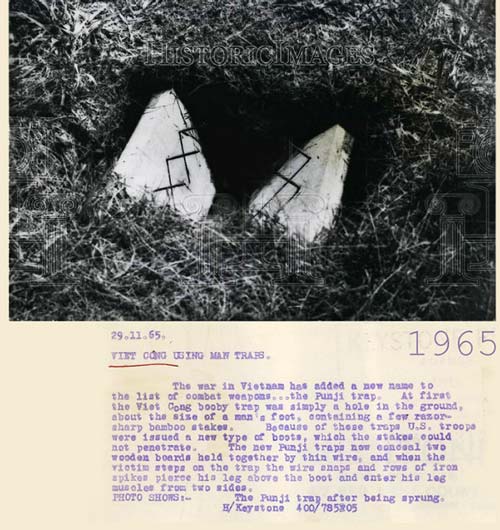
Bucket
A bucket trap was set up in a similar way. The Vietnamese screwed downward-pointing spikes or large hooks into the metal walls for catching fish. When trying to pull the leg out, all this dug into the flesh, and it was impossible to remove the bucket from the leg in the field. In addition, it was impossible to remain in place - perfectly camouflaged snipers were usually based around the established traps.
Vietnamese souvenir
It's a terrible thing. The leg fell towards the pin protruding from the bottom of the camouflaged hole. At the same time, under the soldier’s weight, the ropes pulled out the sharpened metal rods hidden there from the walls. The leg was fixed tightly and it was possible to remove these bars only in the hospital. By that time, it was usually impossible to save the leg, but as a souvenir, the newly crippled person was given a pin removed from his leg. Hence the name.
"Meat grinder"
Another equally cruel trap. If a person fell into this monstrous meat grinder, he was guaranteed to be dead. Under his own weight, he turned into a colander, falling into a neck-high hole while the hooked pins dug deep into his body.
Flying Traps
In the jungle you had to watch your step carefully. But if you didn’t look up and to the sides, you could easily run into a poisonous snake with your face or hand, or get hit in the head or chest by a flying trap - a ball pierced with strong bamboo stakes or the same spiked log, released when you hit a trip wire hidden at land.
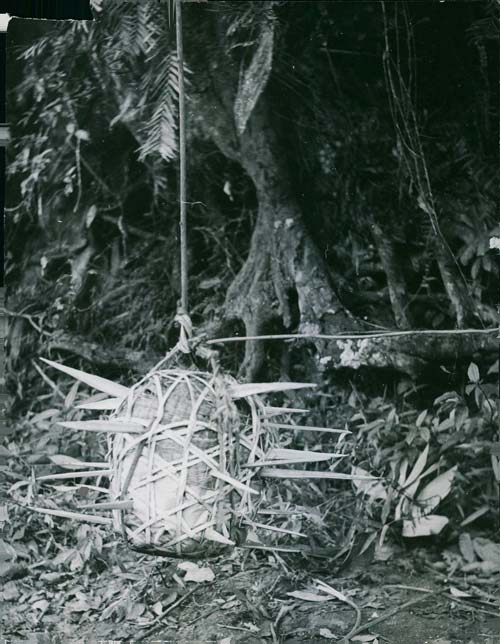
Vietnam's war with America was brutal and unequal in strength. But the fearless Vietnamese fought desperately, using natural resources and their ingenuity.
The Vietnam War lasted from 1964 to 1975. It was attended by the USA, Vietnam, USSR, South Korea, New Zealand, Australia, Thailand, the Philippines, Taiwan, China and the DPRK. The war claimed many lives and had only one goal: the possession of all of Vietnam and the possibility of placing military bases on its territory to control the Asia-Pacific region. The US Army, as it turned out later, was poorly prepared for this war. It was almost impossible for the Americans to conduct ground operations in the local jungle with a bunch of Vietnamese traps set by the local population.
All local rebels dressed in camouflage and knew the terrain very well. It was extremely difficult for American soldiers to notice them. US armored vehicles could not move through the jungle, so the Americans could only rely on infantry and air support. Vietnam's war with America was brutal and unequal in strength. But the fearless Vietnamese fought desperately, using natural resources and their ingenuity. Their traps were truly dangerous.
- Punji. The Vietnamese installed these traps near American bases on the trails, perfectly camouflaging them under a layer of grass or earth. They were extremely difficult to detect. An ordinary punji was designed to fit the size of a human foot, was half a meter deep and resembled a cube with spikes that were lubricated with various wastes. A person who fell into it could not only injure his leg, but also easily get blood poisoning. Other punjas were three-meter inverted cubes. Falling inside, a person died from sharp spikes that reached the length of the groin area. Then the cube turned 180 degrees and waited for a new victim. There was a punji and even more with a lid rotating in different directions, but in the end always returning to a clearly horizontal position. It was impossible to get out of such a trap.
- Bamboo traps. It was usually installed at the entrance to houses. When the enemy entered, a stick with spikes flew at him. The blow was to the head or stomach. Such a trap easily crushed the bones of the skull and ripped open the insides. The Vietnamese installed similar traps, but of a larger size, on the trails in the form of tripwires. Here the blow from her fell to the full height of a person.
- Whip traps. Sometimes the Vietnamese installed a trip wire in the jungle, attaching a bamboo trunk to it, which they bent. Sharp stakes were tied tightly to the end of the trunk. If the enemy touched the fishing line or wire, then the freed trunk dealt an instant blow with stakes from the stomach to the knees.
- Bucket traps. It was similar to the punji, but it used fishhooks set at an angle and the most ordinary buckets. The bucket was buried and carefully camouflaged. When falling into such a trap, sharp hooks dug into the enemy’s leg, causing considerable pain. It was impossible to get out of it without digging up a bucket. Although these Vietnamese traps were not lethal, they greatly reduced the number of enemy combat-ready soldiers.
- Traps with closing sides. The Vietnamese made them from two boards held together with elastic rubber and stretched them. Bamboo was inserted between them and this structure was placed over a dug hole, at the bottom of which stakes or poisonous snakes could be located. Falling into the trap, a person found himself pinned at the level of his stomach.
- Spike board. The traps were camouflaged plates to which a board with stakes was attached. If the opponent stepped on the plate, he received a strong blow from the bottom up with the board.
- Classic stretching. Was on the ground or at a low altitude from it. The trap was very difficult to spot. This was hampered by dense thickets, tall grass, the twilight of the jungle and terrible heat with a humidity of 100%. Exhausted American soldiers at that time often fell into such traps.
The article is written based on the books by Alan Lloyd Peter »Back. Part 1: Across the Fence" and "Back. Part 2: Into the Jungle."
During the Vietnam War
(1964-1973),
Americans were faced with one unexpected and very unpleasant surprise - a large number of
Vietnamese traps
. Due to the natural features of the area - dense jungle, many rivers and swamps, as well as an underdeveloped road network, the Americans could not fully use vehicles, and were forced to rely on helicopters in huge numbers to move troops. In the Vietnamese jungle itself, in the depths of the territory, American troops, having no other option, were forced to move and fight on foot. And this is in conditions of average summer temperatures of more than 30 degrees and one hundred percent humidity. It is also worth remembering what the rainy season is in Vietnam - when tropical rains fall almost continuously for several months, flooding vast areas with water.
The main character of the movie Forrest Gump talks about the rains in Vietnam: “One day it started to rain and didn’t stop for four months. During this time we learned about all types of rain: direct rain, slanting rain, horizontal rain, and even rain that comes from bottom to top.”
American Marines in murky Vietnamese waters
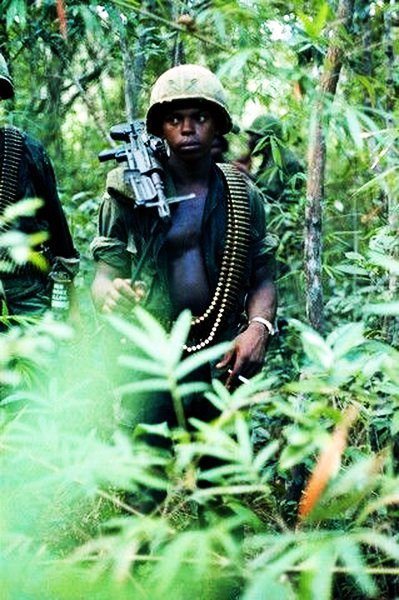
In the wilds of the Vietnamese jungle Soldiers of the South Vietnamese army on the march Vietnamese swamp. Batangan. 1965
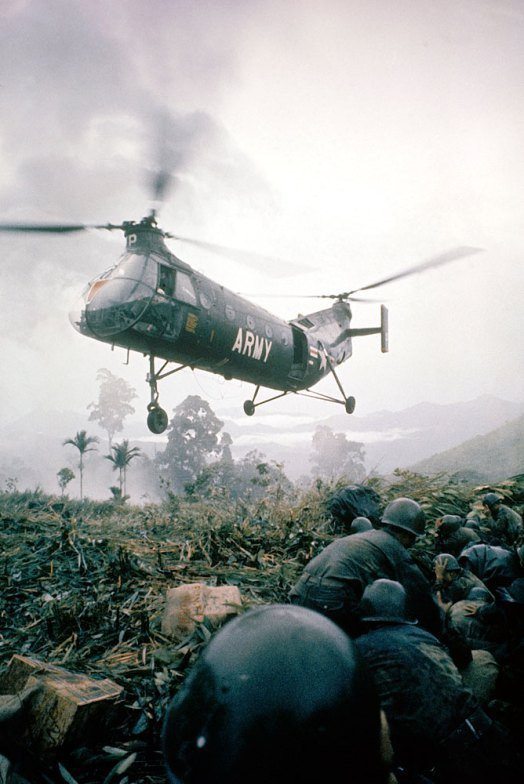
A Piasecki H-21 Shawnee helicopter transports reinforcements and picks up the wounded. Vietnam. The beginning of the war. 1965

An aerial cavalcade of Bell UH-1 "Huey". 1968
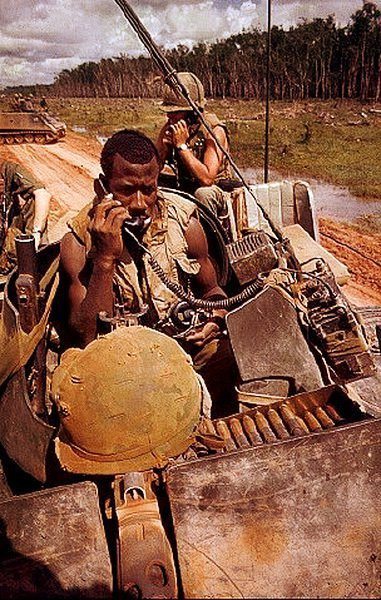
1968 Things were no better in the mountains of Vietnam. Shau region In such specific conditions, when even a few dirt roads turn into an impassable mess, and the use of aviation is problematic, technical superiority is to a certain extent leveled out and Vietnamese traps
become very effective and deadly.
Below are the most popular ones:
Punji
The famous Punji trap
— was installed in large numbers on forest paths, near American bases, and being camouflaged under a thin layer of grass, leaves, soil or water, it was difficult to detect.
The size of the trap
was calculated exactly to fit the foot in the boot.
The stakes were always smeared with feces, carrion and other bad substances. Getting your foot into such a trap
would result in the sole being pierced by the stakes and causing injury, which almost certainly caused blood poisoning.
Bamboo
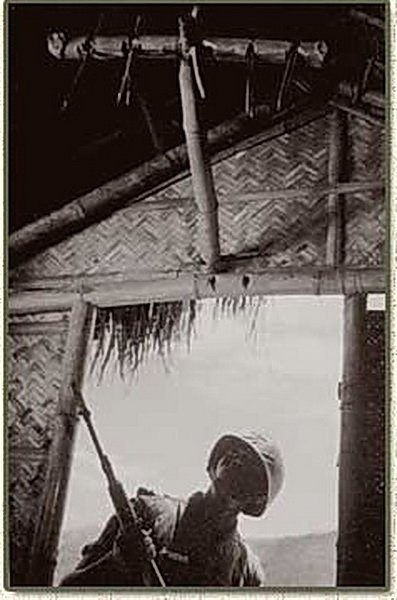
Bamboo trap
- installed in the doors of rural houses.
As soon as the door was opened, a small log with sharp stakes flew out of the opening. Often traps
were set in such a way that the blow would fall on the head - if triggered successfully, this would lead to severe injuries, often fatal.
Sometimes such traps
, but in the form of a large log with stakes and a tripping mechanism using a tripwire, were installed on paths in the jungle.
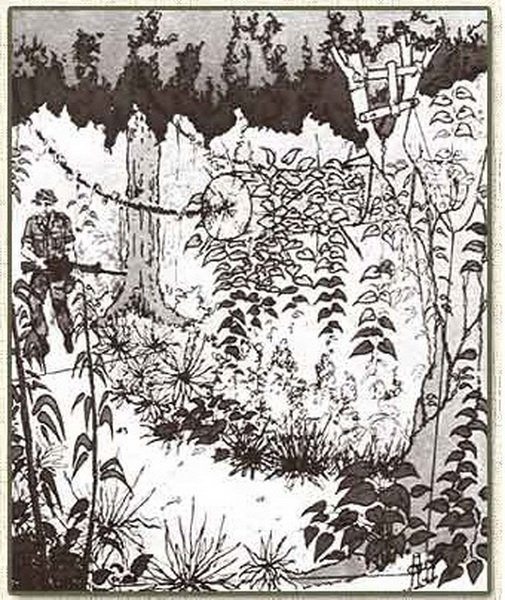
In dense thickets, the log was replaced with a spherical structure. It should be noted that the Vietnamese often made stakes not from metal, but from bamboo - a very hard material, which is used in Southeast Asia
make knives.
Whip Trap
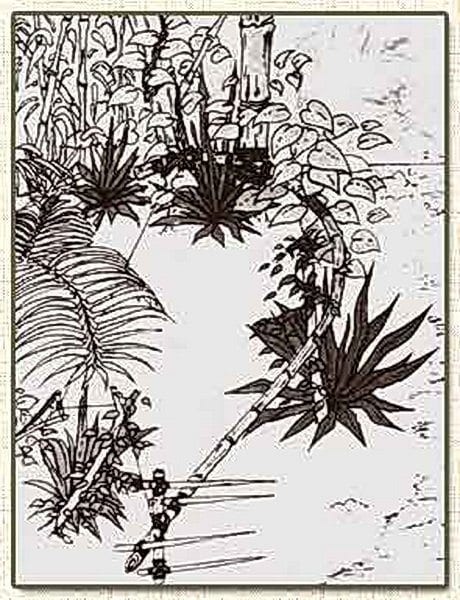
Whip Trap
- often
set along jungle trails.
To do this, a bamboo trunk with long stakes at the ends was bent and connected to a guy wire through a block. As soon as you touched a wire or fishing line (the Vietnamese often used it),
the released bamboo trunk with stakes hit with all its might the area from the knees to the stomach of the person who touched it.
Naturally, all traps were carefully camouflaged
.
Big Punji
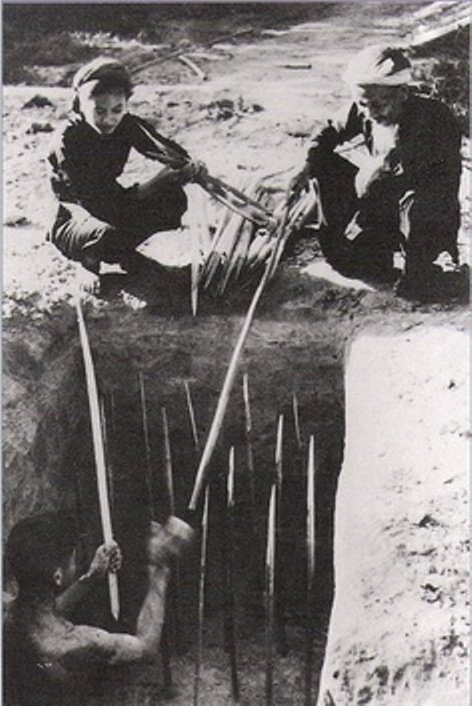
Big Punji
- an enlarged version
of Punji
.
This trap caused much more serious injuries - here the leg was pierced up to the thigh, including the groin area, often with irreversible injuries in the area of the “main male organ”
. The stakes were also smeared with something nasty.
One of the most terrible big Punji
- with a rotating lid.
The lid was attached to a bamboo trunk and rotated freely, always returning to a strictly horizontal position. The lid was covered with grass and leaves on both sides. Having stepped on the platform lid, the victim fell into a deep hole (3 meters or more)
with stakes, the lid was rotated 180 degrees and the trap was again ready for the next victim.
Bucket Trap
Bucket Trap
( bucket trap)
- a bucket with stakes, and often with large fishing hooks, dug into the ground, camouflaged.
The whole horror of this trap
was that the stakes were firmly attached to the bucket at an angle downwards, and if you fell into such
a trap
, it was impossible to pull out your leg - when you tried to pull it out of the bucket, the stakes only dug deeper into your leg.
Therefore, it was necessary to dig out a bucket, and the unfortunate man, along with the bucket on his leg, was evacuated using MEDEVAC
to the hospital.
Side Closing Trap
Side Closing Trap
- stakes
were held together with elastic rubber, stretched, and thin bamboo sticks were inserted between them.
As soon as you fell into such a trap
, breaking the sticks, the doors slammed shut just at the level of the victim’s stomach. Additional stakes may also have been dug into the bottom of the pit.
Spike Board
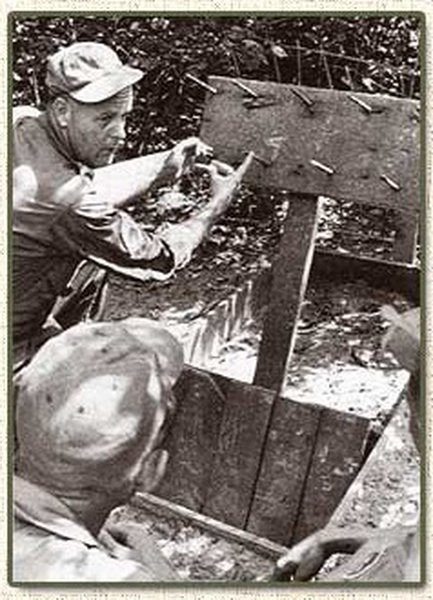
Spike Board
trap (snake board)
- these
traps
, as a rule, were installed in shallow reservoirs, swamps, puddles, etc. As soon as you stepped on the pressure plate, the other end of the board with stakes would forcefully hit upward and towards the person who stepped on it. A successful hit often resulted in death.
Trap cartridge
Trap cartridge
pressure action in a bamboo container. Various cartridges could be used, including hunting cartridges with shot or buckshot.
Although all these traps
and they look impressive, of course, the damage they cause cannot be compared with mines and grenades on tripwires. By constantly mining the territory and setting up tripwires, the Vietnamese managed to turn the presence of the American military on foreign soil into a real hell.
"Pineapple" (pineapple)
"Pineapple"
-
grenades, high-explosive shells and other ammunition suspended from tree branches.
To trigger it, you had to touch the branches. One of the most common traps during the Vietnam War
.
Stretching
— installed on the ground or close to it.
The situation was aggravated by the fact that in the forest floor of the jungle, in the twilight, it is very difficult to notice the trap
, and even more so in forty-degree heat and one hundred percent humidity, which clearly do not contribute to concentration.
The photo from Vietnam shows a well-installed tripwire
with a Chinese hand grenade in the grass. Even with camera flash it is very difficult to notice.

Often under a grenade or other ammunition
a vessel made of thick bamboo filled with a mixture of ammonia nitrate and diesel fuel was installed.
This technique greatly increased the damaging effect of a grenade explosion. So, on December 6, 1968
in the Ho
Chi Minh Trail
, one such
tripwire
led to the death of 5 Marines and injuries of varying degrees of severity to another 12 from the group.
The tripwire was the most common trap during the Vietnam War.
Naturally, as in any other big war, the Vietnamese massively used mines of various types - ordinary push-action, jumping, tripwire
, directed action, which were often set to be non-removable, landmines along roads to blow up vehicles and armored vehicles, as well as ambushes and sabotage behind enemy lines.
To fall into traps
If they didn’t come across their own, the Vietnamese developed a whole signaling system from sticks, leaves and broken branches arranged in a certain way.
An experienced person could use these marks to determine not only that a trap
, but also the type of trap.
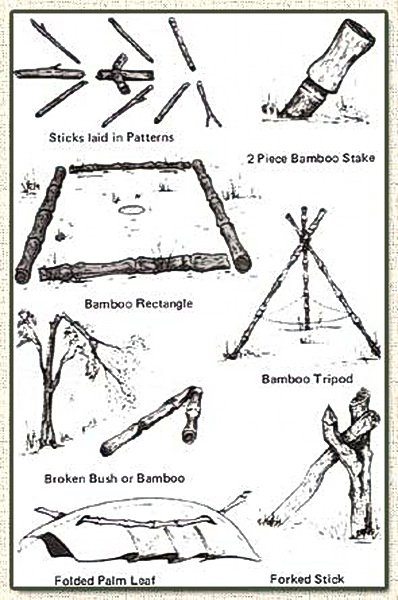
It is worth noting that the North Vietnamese showed amazing resilience, determination and fearlessness in this war. They skillfully used their modest resources, as well as the natural and climatic conditions of their homeland, inflicting the maximum possible damage on the enemy.
This is not to say that the Americans did not struggle with this. Traps
and
the signaling system
were carefully and constantly studied.
Regular training was conducted with personnel, and pocket instructions on traps and their disarming were issued. Miners began to be placed at the head of the groups. Miners at the head of the patrol. Vietnam. April 1972
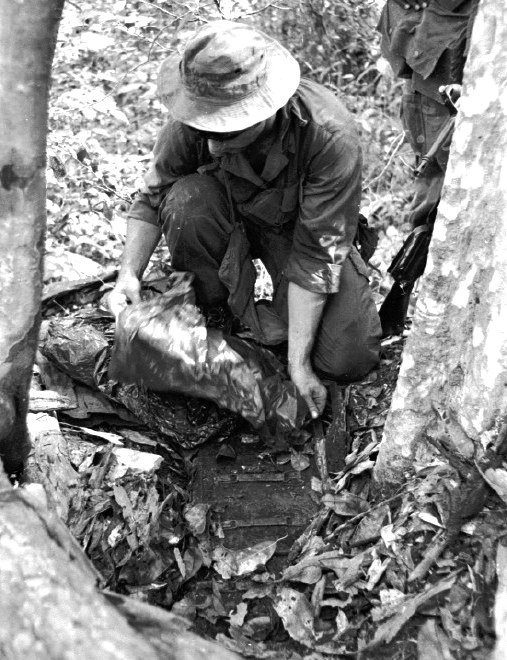
Rewards were paid to local residents for reports of found traps. However, the American military still continued to fall into traps and be blown up throughout the war.
Cu Chi is a rural area about 70 kilometers northwest of Saigon that has become a thorn in the ass of first the French and then the Americans. The same case when “the earth burned under the boots of the invaders.” It was never possible to defeat the local partisans, even though an entire American division (25th Infantry) and a large part of the 18th Division of the South Vietnamese Army were stationed close to their base. The fact is that the partisans dug a whole network of multi-level tunnels with a total length of over 200 kilometers, with many camouflaged exits to the surface, rifle cells, bunkers, underground workshops, warehouses and barracks, densely covered with mines and traps on top.
A large group can order a sightseeing bus; the excursion involves the active participation of tourists in what is happening. For example, they may offer to find a camouflaged entrance to a tunnel in a small patch in the jungle, and then squeeze through this hatch.
Surprisingly, this is generally quite possible; even fairly large Western tourists can climb through, albeit with difficulty. The bunkers have been brought to the surface, and the flat roofs have been replaced with high slopes, so that it is spacious enough to comfortably look at the Viet Cong-shaped mannequins depicting guerrillas in their natural habitat.
Like many other things, metal was in terrible short supply, so the partisans collected numerous unexploded bombs and shells (and an absolutely incredible amount of them were dumped on a tiny patch; the jungle was simply demolished by carpet bombing from B-52s, turning the area into a lunar landscape), sawed , explosives were used to make homemade mines...
...and the metal was forged into spikes and spears for traps in the jungle.
In addition to the workshops, there was a dining room, a kitchen (with a specially constructed external smokeless hearth that did not give away the place of cooking with a column of smoke), a uniform sewing shop...
...and, of course, a room for political information.
And tunnels. A three-level system of tunnels, secretly carved into the hard clay soil with primitive tools by numerous groups of three or four people. One digs, one drags the earth out of the tunnel to a vertical shaft, one lifts it up, and another drags it somewhere and hides it under leaves or throws it into the river.
When the team makes its way to the neighboring one, a thick pipe made of a hollow bamboo trunk is inserted into the vertical shaft for ventilation, the shaft is filled up, and the bamboo on top is disguised as a termite mound, stump, or something else.
The Americans used dogs to search for entrances to tunnels and ventilation shafts. Then they began to hide captured uniforms there, usually M65 jackets, which the Americans often abandoned when providing first aid and evacuating the wounded. The dogs smelled a familiar smell, mistook it for their own and ran past.
If they did find the entrance, they tried to fill it with water or fire tear gas into it. But a multi-level system of locks and water castles protected the tunnels quite reliably: only a small segment was lost, the partisans simply brought down its walls on both sides and forgot about its existence, eventually digging out a workaround.
Since numerous shelling and bombing did not bring the desired result, the Americans eventually had to go underground themselves. In Tunnel rats, “tunnel rats”, they recruited short, desperate guys who were ready to climb into the unknown with one pistol, in which they were awaited by cramped conditions that did not allow them to breathe, darkness, mines, traps, poisonous snakes, scorpions and, after all this, if they were lucky - evil partisans.
Now sixty meters of tunnels have been widened and illuminated so that tourists can squeeze through them. Even in them you have to move in an eternal half-squat, while simultaneously scratching the walls with your hips, elbows, shoulders and head. It's like running inside an endless nightstand.
The jungle in Cu Chi was fraught with many unpleasant surprises, from the already mentioned mines, which even blew up tanks like this M41, to the famous movie homemade traps, some of which can be seen up close.
"Tiger Trap" Ji Ai walks along calmly, suddenly the ground under his feet opens up and he falls to the bottom of a hole studded with stakes. If he is unlucky and does not die immediately, but screams in pain, his comrades will gather nearby, trying to pull the unfortunate man out. Need I say that around the trap in several places there are exits from the tunnels to the surface, to camouflaged sniper positions?
Or more humane traps, “Vietnamese souvenirs”. A soldier steps on an inconspicuous hole, covered on top with a piece of paper with leaves...
The leg falls through, the pin from below pierces it, the pins on the sides not only pierce it, but also prevent it from being pulled out. As a rule, the soldier did not die, but as a result he lost his leg, and then received pins removed from his leg in a Saigon hospital as a souvenir. Hence the name.
The next couple of photos show a similar design.
As you probably already noticed, special attention was paid not only to the task of piercing the adversary, but also to pin him in place and not let him get off the hook. This “basket” was placed in flooded rice fields or near river banks, hidden under water. A paratrooper jumps out of a helicopter or boat, OPA! - we've arrived...
However, it happened that the task was not to injure, but to kill. Then they put on grinds like this, in which G.I. quickly stuffed himself under his own weight.
For those who liked to enter the house without knocking, simply by knocking down the door with a valiant blow, such a device was hung above it. The slow ones went straight to the other world, the quick ones managed to put the machine gun forward - for such, the lower half of the trap was suspended on a separate loop. So the efficient one, as the Vietnamese guide put it, then went to Thailand, a paradise for transvestites.
Well, the simplest, most reliable and popular design in the film industry. Since it flies much faster than the “home” one, there is no need to worry about having two halves. And so it will sweep away. The guide likes her the most.
Vietnamese dungeons:
Women's fashion and beauty
During the Vietnam War (1964-1973), Americans faced one unexpected and very unpleasant surprise - a large number of Vietnamese traps. Due to the natural features of the area - dense jungle, many rivers and swamps, as well as an underdeveloped road network, the Americans could not fully use vehicles, and were forced to rely on helicopters in huge numbers to move troops. In the Vietnamese jungle itself, in the depths of the territory, American troops, having no other option, were forced to move and fight on foot. And this is in conditions of average summer temperatures of more than 30 degrees and one hundred percent humidity. It is also worth remembering what the rainy season is in Vietnam - when tropical rains fall almost continuously for several months, flooding vast areas with water. The main character of the movie Forrest Gump talks about the rains in Vietnam: “One day it started to rain and didn’t stop for four months. During this time we learned about all types of rain: direct rain, slanting rain, horizontal rain, and even rain that comes from bottom to top.”
American Marines in murky Vietnamese waters
In the wilds of the Vietnamese jungle
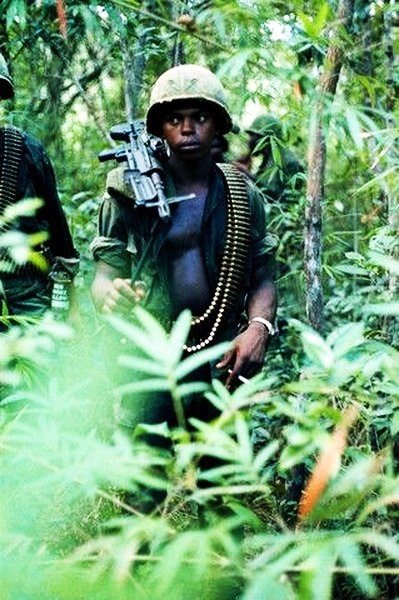
A Piasecki H-21 Shawnee helicopter transports reinforcements and picks up the wounded. Vietnam. The beginning of the war. 1965
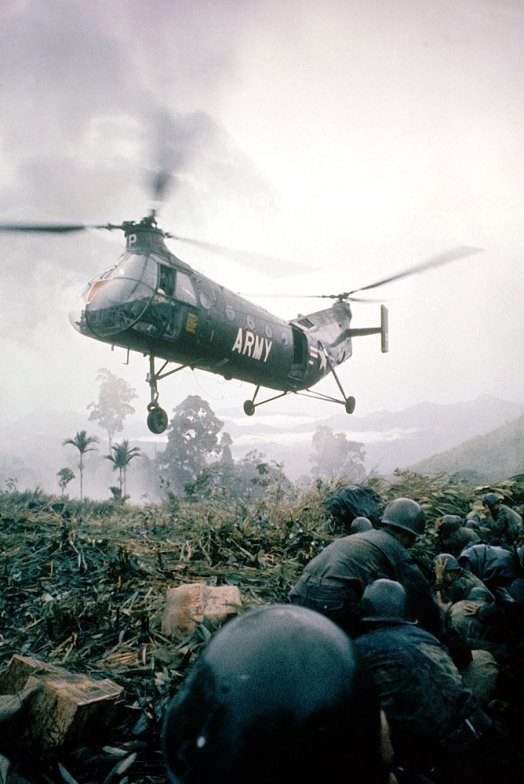
South Vietnamese Army soldiers on the march
Vietnamese swamp. Batangan. 1965
An aerial cavalcade of Bell UH-1 "Huey". 1968
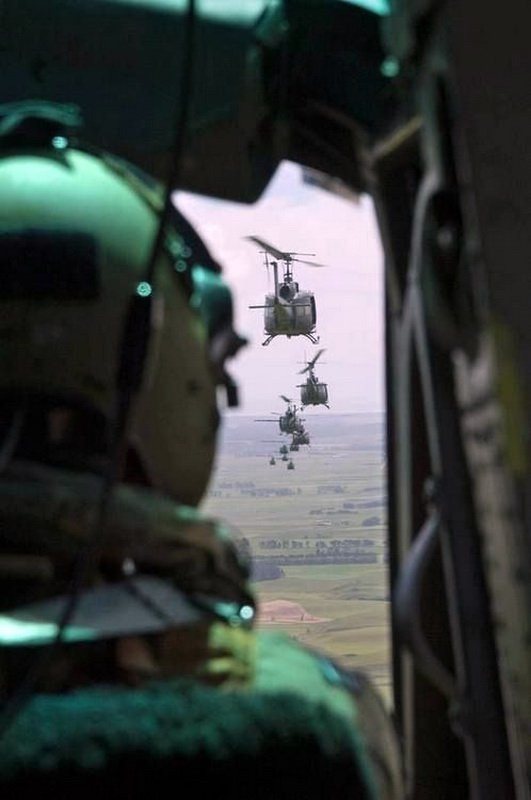
A column of the 25th Division on an M113 armored personnel carrier (APC) is moving along the “federal” road Tau Ninh-Dau Tieng. 1968
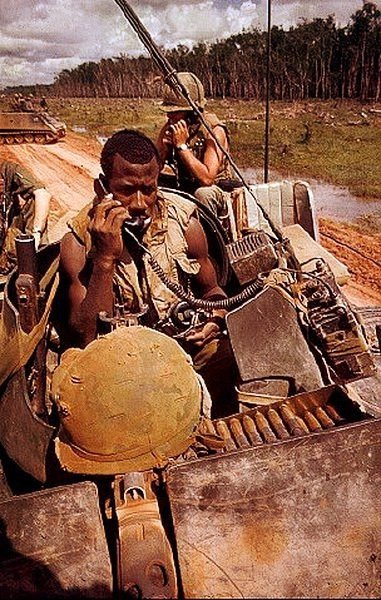
In such specific conditions, when even a few dirt roads turn into an impassable mess, and the use of aviation is problematic, the technical superiority of the American army is to a certain extent leveled out and Vietnamese traps become very effective and deadly. Here are some of them.
The famous Punji trap was installed in large numbers on forest paths, near American bases, and being camouflaged under a thin layer of grass, leaves, soil or water, it was difficult to detect. The size of the trap was calculated exactly to fit the foot in the boot. The stakes were always smeared with feces, carrion and other bad substances. Getting your foot into such a trap, having your sole pierced by stakes and being wounded almost certainly caused blood poisoning. They often had a more complex design.
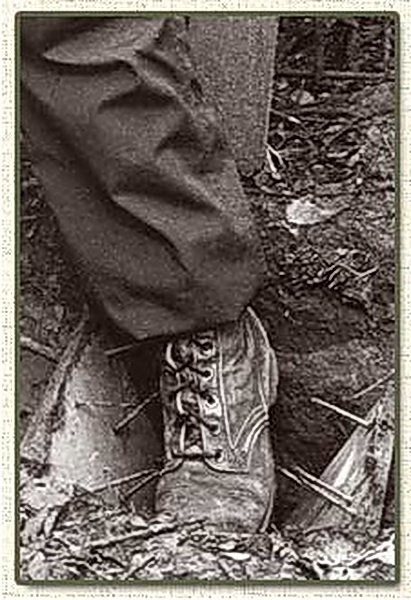
Broken shoe
Bamboo trap - installed in the doors of rural houses. As soon as the door was opened, a small log with sharp stakes flew out of the opening. Often traps were set in such a way that the blow would fall on the head - if triggered successfully, this would lead to severe injuries, often fatal.
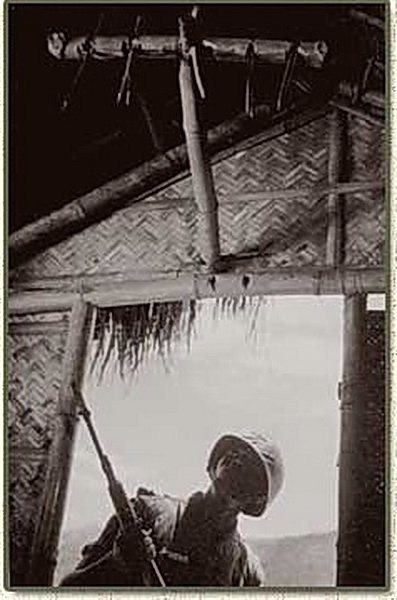
Sometimes such traps, but in the form of a large log with stakes and a trigger mechanism using a tripwire, were installed on paths in the jungle. In dense thickets, the log was replaced with a spherical structure. It should be noted that the Vietnamese often made stakes not from metal, but from bamboo - a very hard material from which knives are made in Southeast Asia.
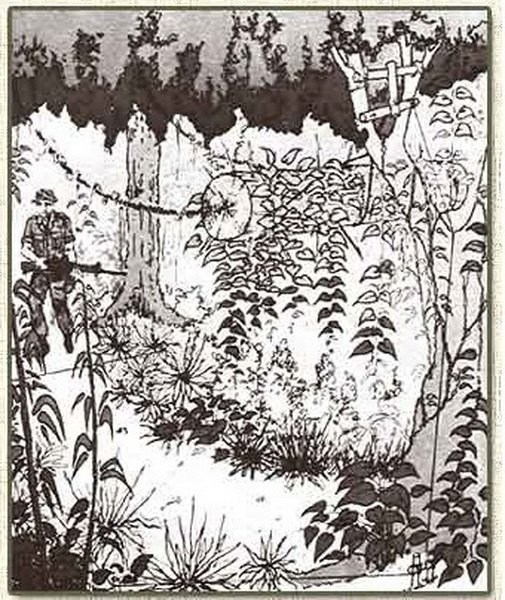
Whip Trap - often set along jungle trails. To do this, a bamboo trunk with long stakes at the ends was bent and connected to a guy wire through a block. As soon as you touched a wire or fishing line (the Vietnamese often used it), the released bamboo trunk with stakes hit with all its might the area from the knees to the stomach of the person who touched it. Naturally, all traps were carefully camouflaged.

Big Punji is a larger version of Punji. This trap inflicted much more serious injuries - here the leg was pierced up to the thigh, including the groin area, often with irreversible injuries in the area of the “main male organ”. The stakes were also smeared with something nasty.
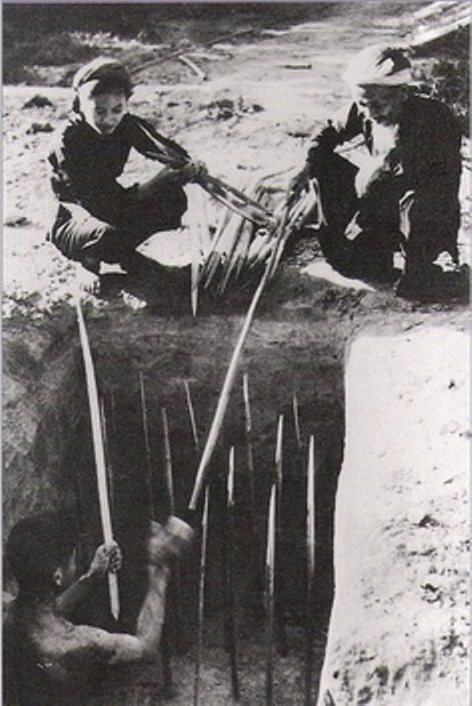
One of the scariest big Punjis is the one with the rotating lid. The lid was attached to a bamboo trunk and rotated freely, always returning to a strictly horizontal position. The lid was covered with grass and leaves on both sides. Having stepped on the platform lid, the victim fell into a deep hole (3 meters or more) with stakes, the lid was rotated 180 degrees and the trap was again ready for the next victim.
Bucket Trap (bucket trap) - a bucket with stakes, and often with large fishing hooks, dug into the ground, camouflaged. The whole horror of this trap was that the stakes were firmly attached to the bucket at an angle downwards, and if you fell into such a trap, it was impossible to pull out your leg - when you tried to pull it out of the bucket, the stakes only dug deeper into your leg. Therefore, it was necessary to dig out a bucket, and the unfortunate man, along with the bucket on his leg, was evacuated using MEDEVAC to the hospital.
Side Closing Trap - two boards with stakes were held together with elastic rubber, stretched, and thin bamboo sticks were inserted between them. As soon as you fell into such a trap, breaking the sticks, the doors slammed shut just at the level of the victim’s stomach. Additional stakes may also have been dug into the bottom of the pit.

Spike Board Trap - These traps were usually installed in shallow ponds, swamps, puddles, etc. As soon as you stepped on the pressure plate, the other end of the board with stakes would forcefully hit upward and towards the person who stepped on it. A successful hit often resulted in death. An example of such a trap being triggered from the film “Southern Hospitality”.
The Vietnamese have launched mass production of traps
Press-action cartridge trap in a bamboo container. Various cartridges could be used, including hunting cartridges with shot or buckshot. Although all these traps look impressive, of course, the damage they cause cannot be compared with mines and tripwire grenades. By constantly mining the territory and setting up tripwires, the Vietnamese managed to turn the presence of the American military on foreign soil into a real hell.
"Pineapple" - grenades, high-explosive shells and other ammunition suspended from tree branches. To trigger it, you had to touch the branches. One of the most common traps during the Vietnam War.
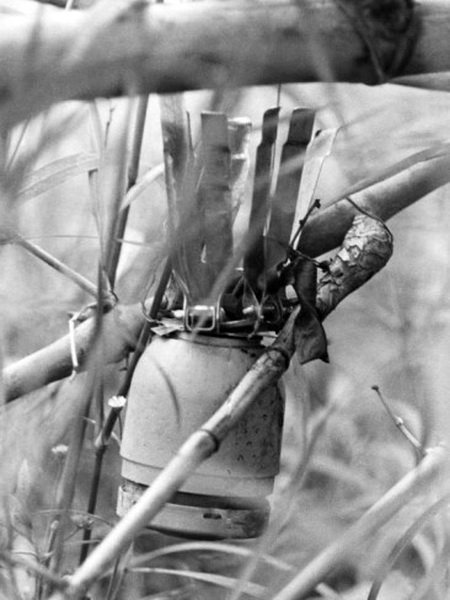
Stretching - installed on the ground or close to it. The situation was aggravated by the fact that in the forest floor of the jungle, in the twilight, it is very difficult to notice the trap, and even more so in forty-degree heat and one hundred percent humidity, which clearly do not contribute to concentration.
The photo from Vietnam shows a well-installed tripwire with a Chinese hand grenade in the grass. Even with camera flash it is very difficult to notice.
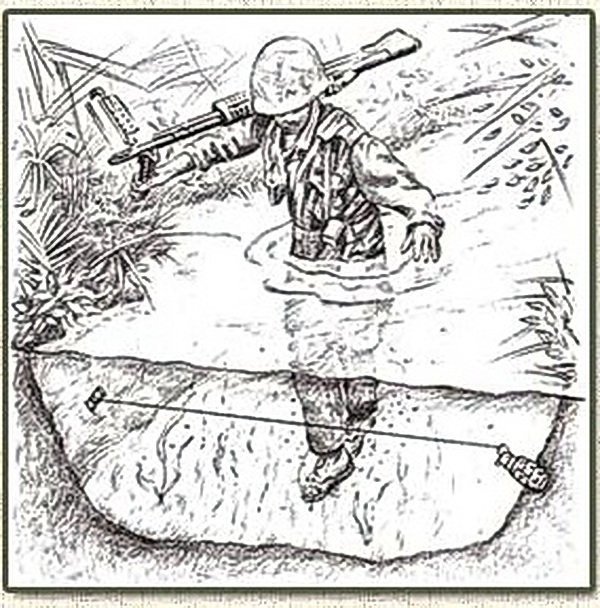
Good shot. An explosion of ammunition at a Marine base as a result of sabotage. Vietnam. March 18, 1968
To prevent their own people from falling into traps, the Vietnamese developed an entire signaling system of sticks, leaves and broken branches arranged in a certain way. An experienced person could use these marks to determine not only that a trap was installed nearby, but also the type of trap.
Trap signs
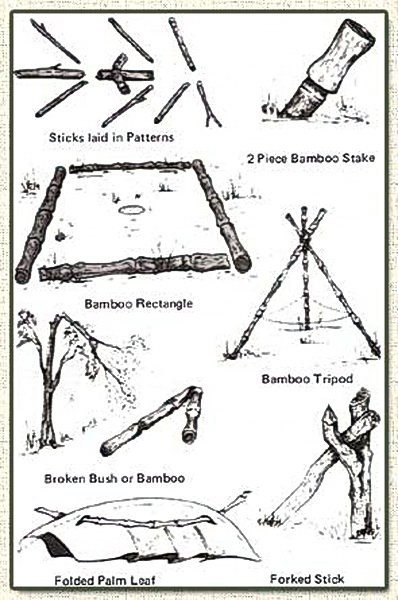
This is not to say that the Americans did not struggle with this. The traps and signaling system were carefully and constantly studied. Regular training was conducted with personnel, and pocket instructions on traps and their disarming were issued. Miners began to be placed at the head of the groups.
Disarming a trap
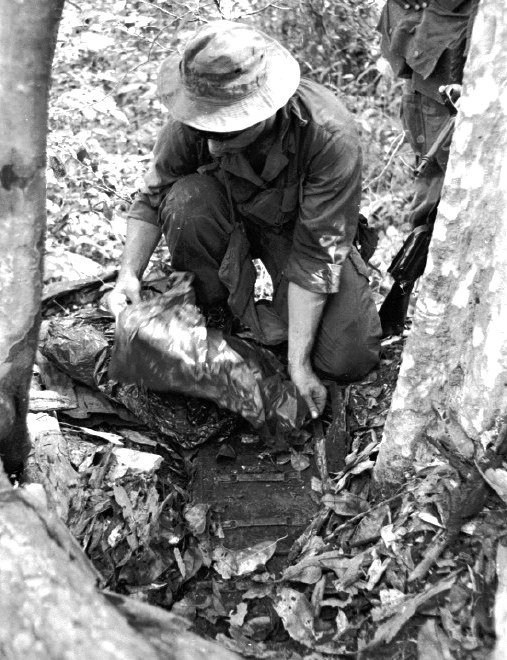
Rewards were paid to local residents for reports of found traps. USMC announcement of reward for reporting decoys
However, the American military still continued to fall into traps and be blown up throughout the war.
Cu Chi is a rural area about 70 kilometers northwest of Saigon that has become a thorn in the side of first the French and then the Americans. The same case when “the earth burned under the boots of the invaders.” It was never possible to defeat the local partisans, even though an entire American division (25th Infantry) and a large part of the 18th Division of the South Vietnamese Army were stationed close to their base. The fact is that the partisans dug a whole network of multi-level tunnels with a total length of over 200 kilometers, with many camouflaged exits to the surface, rifle cells, bunkers, underground workshops, warehouses and barracks, densely covered with mines and traps on top.
They are quite simple to describe: these are underground fortifications that are perfectly camouflaged in the local tropical forest. The main purpose of their creation was to deliver unexpected blows to the enemy during the years of American aggression. The tunnel system itself was thought out in the most careful way, thereby making it possible to destroy the American enemy almost everywhere. An intricate zigzag network of underground passages radiates away from the main tunnel with many branches, some of them are independent shelters, and some end unexpectedly due to the geographical features of the area.
The cunning Vietnamese, in order to save time and effort, did not dig the tunnels very deeply, but the calculations were so accurate that if tanks and heavy armored personnel carriers passed over them, or were hit by artillery shells and bomb attacks, the recesses did not collapse and continued to faithfully serve their creators.
To this day, multi-level underground rooms, equipped with secret hatches covering the passages between floors, have been preserved in their original form. In some places in the tunnel system, special types of plugs are installed, designed to block the enemy's path or stop the penetration of poisonous gases. Throughout the dungeons there are cleverly hidden ventilation hatches that open to the surface in a variety of unnoticeable openings. Plus, some passages at that time could perfectly serve as fortified shooting points, which, naturally, was always a big surprise for the enemy.
And even this was not enough for the Vietnamese. The tunnels and approaches to them were equipped with a large number of ingenious death traps and masterfully camouflaged “wolf” pits. For greater security, anti-personnel and anti-tank mines were installed at the entrances and exits, which have now, of course, been destroyed.
Often, during wartime, entire villages lived in the tunnels, and this allowed the Vietnamese to save many lives. There were weapons and food warehouses, smokeless kitchens, hospitals for the wounded, as well as living quarters, camp headquarters, shelters for women, the elderly and children. It’s not like a village, a whole city underground! Even during hostilities, the Vietnamese did not forget about culture and education: school classes were set up in large underground rooms, and films and theatrical performances were also shown there. But, for all that, this entire underground world was carefully hidden and disguised
Since numerous shelling and bombing did not bring the desired result, the Americans eventually had to go underground themselves. The Tunnel rats, “tunnel rats,” recruited short, thin, desperate guys, ready with one pistol to climb into the unknown, in which they were awaited by cramped conditions that did not allow them to breathe, darkness, mines, traps, poisonous snakes, scorpions and, after all this, if you're lucky - evil partisans. A three-level system of tunnels, secretly carved out of the hard clay soil with primitive tools by numerous groups of three or four people. One digs, one drags the earth out of the tunnel to a vertical shaft, one lifts it up, and another drags it somewhere and hides it under leaves or throws it into the river. When the team makes its way to the neighboring one, a thick pipe made of a hollow bamboo trunk is inserted into the vertical shaft for ventilation, the shaft is filled up, and the bamboo on top is disguised as a termite mound, stump, or something else. Only a Vietnamese could squeeze through such a gap. The Americans used dogs to search for entrances to tunnels and ventilation shafts. Then they began to hide captured uniforms there, usually M65 jackets, which the Americans often abandoned when providing first aid and evacuating the wounded. The dogs smelled a familiar smell, mistook it for their own and ran past. If they did find the entrance, they tried to fill it with water or fire tear gas into it. But a multi-level system of locks and water castles protected the tunnels quite reliably: only a small segment was lost, the partisans simply brought down its walls on both sides and forgot about its existence, eventually digging out a workaround. Like many other things, metal was in terrible short supply, so the partisans collected numerous unexploded bombs and shells (and an absolutely incredible amount of them were dumped on a tiny patch; the jungle was simply demolished by carpet bombing from B-52s, turning the area into a lunar landscape), sawed , explosives were used to make homemade mines... ...and the metal was forged into spikes and spears for traps in the jungle.
In addition to the workshops, there was a dining room, a kitchen (with a specially constructed external smokeless hearth that did not give away the place of cooking with a column of smoke), a uniform sewing shop….
Let's look at the traps used by Vietnamese guerrillas during the war and how they ruined the lives of the occupiers.
Vietnamese traps, being very insidious and effective products, at one time spoiled a lot of blood for Americans. Perhaps it will be useful to you too.
The jungle in Cu Chi was fraught with many unpleasant surprises, from the already mentioned mines, which even blew up tanks like this M41, to the famous movie homemade traps, some of which can be seen up close.
"Tiger Trap" Ji Ai walks along calmly, suddenly the ground under his feet opens up and he falls to the bottom of a hole studded with stakes. If he is unlucky and does not die immediately, but screams in pain, his comrades will gather nearby, trying to pull the unfortunate man out. Need I say that around the trap in several places there are exits from the tunnels to the surface, to camouflaged sniper positions?
Or more humane traps, “Vietnamese souvenirs”. This is a pretty high-tech trap. There are pins at the bottom; in addition, ropes connected to nails are stretched under the round platform. When a soldier steps on an inconspicuous hole, covered on top with a piece of paper with leaves...
The leg falls through and the first thing he does is pierce the leg with pins at the bottom, at the same time the ropes are stretched and pull nails out of the holes, which pierce the leg from the sides, while fixing it and making it impossible to pull it out. As a rule, the soldier did not die, but as a result he lost his leg, and then received pins removed from his leg in a Saigon hospital as a souvenir. Hence the name.
As you probably already noticed, special attention was paid not only to the task of piercing the adversary, but also to pin him in place and not let him get off the hook. This “basket” was placed in flooded rice fields or near river banks, hidden under water. A paratrooper jumps out of a helicopter or boat, OPA! - we've arrived...
However, it happened that the task was not to injure, but to kill. Then they put on grinds like this, in which G.I. quickly stuffed himself under his own weight. One... Or two... For those who liked to enter the house without knocking, simply knocking down the door with a valiant blow, such a device was hung above it. The slow one went straight to the other world, the quick one managed to put a machine gun forward - for such, the lower half of the trap was suspended on a separate loop and made a sofa out of his eggs.

Clamshell trap. The simplest and most common trap. They say that at one time it was mass-produced by Vietnamese schoolchildren during labor lessons. The principle is simple. Placed in a small hole and covered with leaves. When the enemy steps on it, under the weight of the foot, the boards are dented and the nails, previously smeared with manure, are pierced into the foot. Blood poisoning is guaranteed.
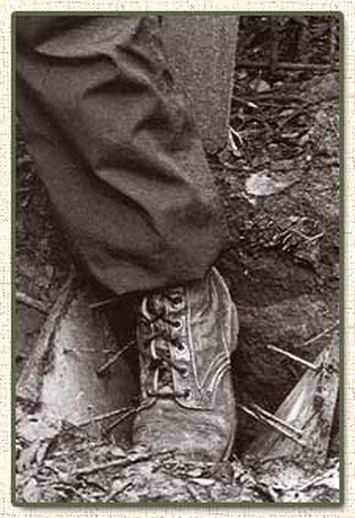
Board with spades. It is made on the principle of a rake, at the end of which there is a board with nails. When the enemy steps on the “pedal”, the board joyfully jumps up and hits the soldier in the chest, either in the face, or in the neck, or wherever it hits.
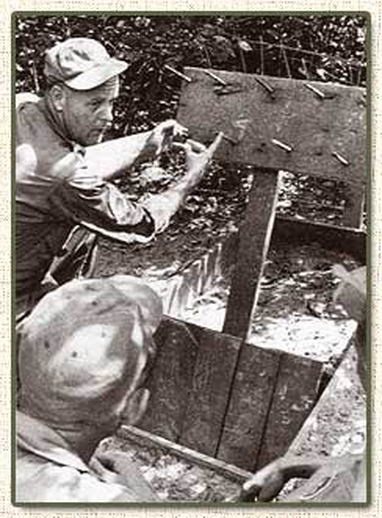
Sliding trap. It consists of two wooden boards moving along guides and studded with pins. The boards are moved apart, a support is placed between them, and they are wrapped with an elastic rubber band (or Pilates tape). When the support holding the slats moves, the latter, under the action of the cord, slide along the guides towards each other. But they are not destined to meet, because someone’s soft body is already between them.
The article is written based on the books by Alan Lloyd Peter “Back”. Part 1: Across the Fence" and ""Back. Part 2: Into the Jungle."
During the Vietnam War (1964-1973), Americans faced one unexpected and very unpleasant surprise - a large number of Vietnamese traps. Due to the natural features of the area - dense jungle, many rivers and swamps, as well as an underdeveloped road network, the Americans could not fully use vehicles, and were forced to rely on helicopters in huge numbers to move troops. In the Vietnamese jungle itself, in the depths of the territory, American troops, having no other option, were forced to move and fight on foot. And this is in conditions of average summer temperatures of more than 30 degrees and one hundred percent humidity. It is also worth remembering what the rainy season is in Vietnam - when tropical rains fall almost continuously for several months, flooding vast areas with water. The main character of the film “Forrest Gump” talks about the rains in Vietnam: “One day it started to rain and did not stop for four months. During this time we learned about all types of rain: direct rain, slanting rain, horizontal rain, and even rain that comes from bottom to top.”
American Marines in murky Vietnamese waters
In the wilds of the Vietnamese jungle
Vietnamese swamp. Batangan. 1965
South Vietnamese Army soldiers on the march
A Piasecki H-21 Shawnee helicopter transports reinforcements and picks up the wounded. Vietnam. The beginning of the war. 1965
An aerial cavalcade of the Bell UH-1 "Huey". 1968
A column of the 25th Division on an M113 armored personnel carrier (APC) is moving along the “federal” road Tau Ninh-Dau Tieng. 1968
It was no better in the mountains of Vietnam. Shau District
In such specific conditions, when even a few dirt roads turn into an impassable mess, and the use of aviation is problematic, the technical superiority of the American army is to a certain extent leveled out and Vietnamese traps become very effective and deadly. Here are some of them.
The famous Punji trap was installed in large numbers on forest paths, near American bases, and being camouflaged under a thin layer of grass, leaves, soil or water, it was difficult to detect. The size of the trap was calculated exactly to fit the foot in the boot. The stakes were always smeared with feces, carrion and other bad substances. Getting your foot into such a trap, having your sole pierced by stakes and being wounded almost certainly caused blood poisoning. They often had a more complex design.
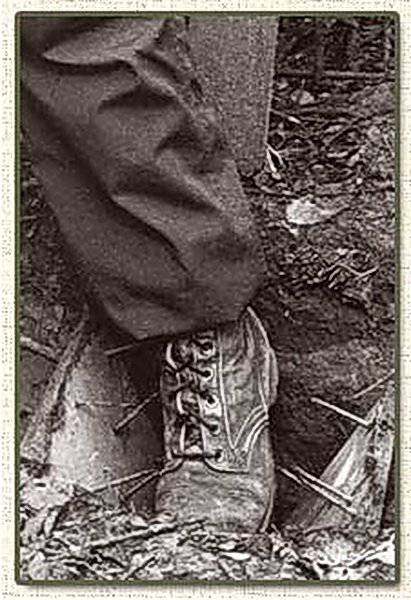
Broken shoe
Bamboo trap - installed in the doors of rural houses. As soon as the door was opened, a small log with sharp stakes flew out of the opening. Often traps were set in such a way that the blow would fall on the head - if triggered successfully, this would lead to severe injuries, often fatal.
Sometimes such traps, but in the form of a large log with stakes and a trigger mechanism using a tripwire, were installed on paths in the jungle.
In dense thickets, the log was replaced with a spherical structure. It should be noted that the Vietnamese often made stakes not from metal, but from bamboo - a very hard material from which knives are made in Southeast Asia. Whip Trap - often set along jungle trails. To do this, a bamboo trunk with long stakes at the ends was bent and connected to a guy wire through a block. As soon as you touched a wire or fishing line (the Vietnamese often used it), the released bamboo trunk with stakes hit with all its might the area from the knees to the stomach of the person who touched it. Naturally, all traps were carefully camouflaged. Big Punji is a larger version of Punji. This trap inflicted much more serious injuries - here the leg was pierced up to the thigh, including the groin area, often with irreversible injuries in the area of the “main male organ”. The stakes were also smeared with something nasty. One of the scariest big Punjis is the one with the rotating lid. The lid was attached to a bamboo trunk and rotated freely, always returning to a strictly horizontal position. The lid was covered with grass and leaves on both sides. Having stepped on the platform lid, the victim fell into a deep hole (3 meters or more) with stakes, the lid was rotated 180 degrees and the trap was again ready for the next victim. Bucket Trap (bucket trap) - a bucket with stakes, and often with large fishing hooks, dug into the ground, camouflaged. The whole horror of this trap was that the stakes were firmly attached to the bucket at an angle downwards, and if you fell into such a trap, it was impossible to pull out your leg - when you tried to pull it out of the bucket, the stakes only dug deeper into your leg. Therefore, it was necessary to dig out a bucket, and the unfortunate man, along with the bucket on his leg, was evacuated using MEDEVAC to the hospital. Side Closing Trap - two boards with stakes were held together with elastic rubber, stretched, and thin bamboo sticks were inserted between them. As soon as you fell into such a trap, breaking the sticks, the doors slammed shut just at the level of the victim’s stomach. Additional stakes may also have been dug into the bottom of the pit. Spike Board Trap - These traps were usually installed in shallow ponds, swamps, puddles, etc. As soon as you stepped on the pressure plate, the other end of the board with stakes would forcefully hit upward and towards the person who stepped on it. A successful hit often resulted in death. An example of such a trap being triggered from the film “Southern Hospitality”.
The Vietnamese have launched mass production of traps
Press-action cartridge trap in a bamboo container. Various cartridges could be used, including hunting cartridges with shot or buckshot.
Although all these traps look impressive, of course, the damage they cause cannot be compared with mines and tripwire grenades. By constantly mining the territory and setting up tripwires, the Vietnamese managed to turn the presence of the American military on foreign soil into a real hell.
"Pineapple" - grenades, high-explosive shells and other ammunition suspended from tree branches. To trigger it, you had to touch the branches. One of the most common traps during the Vietnam War. Stretching - installed on the ground or close to it. The situation was aggravated by the fact that in the forest floor of the jungle, in the twilight, it is very difficult to notice the trap, and even more so in forty-degree heat and one hundred percent humidity, which clearly do not contribute to concentration. The photo from Vietnam shows a well-installed tripwire with a Chinese hand grenade in the grass. Even with camera flash it is very difficult to notice. Very often the Vietnamese installed tripwires underwater. It was almost impossible to detect them in muddy water.
Often, a vessel made of thick bamboo filled with a mixture of ammonia nitrate and diesel fuel was installed under a grenade or other ammunition. This technique greatly increased the damaging effect of a grenade explosion. So, on December 6, 1968, in the Ho Chi Minh Trail area, one such tripwire led to the death of 5 Marines and injuries of varying degrees of severity to another 12 from the group. The tripwire was the most common trap during the Vietnam War.
Naturally, as in any other big war, the Vietnamese massively used mines of various types - ordinary push-action, jumping, tripwire, directional, which were often set to non-removable, landmines along the roads to blow up vehicles and armored vehicles, as well as ambushes and sabotage behind enemy lines.
The article is written based on the books by Alan Lloyd Peter »Back. Part 1: Across the Fence" and "Back. Part 2: Into the Jungle."
During the Vietnam War
(1964-1973),
Americans were faced with one unexpected and very unpleasant surprise - a large number of
Vietnamese traps
. Due to the natural features of the area - dense jungle, many rivers and swamps, as well as an underdeveloped road network, the Americans could not fully use vehicles, and were forced to rely on helicopters in huge numbers to move troops. In the Vietnamese jungle itself, in the depths of the territory, American troops, having no other option, were forced to move and fight on foot. And this is in conditions of average summer temperatures of more than 30 degrees and one hundred percent humidity. It is also worth remembering what the rainy season is in Vietnam - when tropical rains fall almost continuously for several months, flooding vast areas with water.
The main character of the movie Forrest Gump talks about the rains in Vietnam: “One day it started to rain and didn’t stop for four months. During this time we learned about all types of rain: direct rain, slanting rain, horizontal rain, and even rain that comes from bottom to top.”
American Marines in muddy Vietnamese water In the depths of the Vietnamese jungle Soldiers of the South Vietnamese army on the march Vietnamese swamp.
Batangan. 1965 Piasecki H-21 Shawnee helicopter transfers reinforcements and picks up wounded. Vietnam. The beginning of the war. 1965 Aerial Cavalcade of Bell UH-1 "Huey". 1968 A column of the 25th Division on an M113 armored personnel carrier (APC) moves along the “federal” road Tau Ninh-Dau Tieng. 1968 Things were no better in the mountains of Vietnam. Shau region In such specific conditions, when even a few dirt roads turn into an impassable mess, and the use of aviation is problematic, technical superiority is to a certain extent leveled out and Vietnamese traps
become very effective and deadly.
Below are the most popular ones:
Punji
The famous Punji trap
— was installed in large numbers on forest paths, near American bases, and being camouflaged under a thin layer of grass, leaves, soil or water, it was difficult to detect.
The size of the trap
was calculated exactly to fit the foot in the boot.
The stakes were always smeared with feces, carrion and other bad substances. Getting your foot into such a trap
would result in the sole being pierced by the stakes and causing injury, which almost certainly caused blood poisoning.
Bamboo
Bamboo trap
- installed in the doors of rural houses.
As soon as the door was opened, a small log with sharp stakes flew out of the opening. Often traps
were set in such a way that the blow would fall on the head - if triggered successfully, this would lead to severe injuries, often fatal.
Sometimes such traps
, but in the form of a large log with stakes and a tripping mechanism using a tripwire, were installed on paths in the jungle.
In dense thickets, the log was replaced with a spherical structure. It should be noted that the Vietnamese often made stakes not from metal, but from bamboo - a very hard material, which is used in Southeast Asia
make knives.
Whip Trap
Whip Trap
- often
set along jungle trails.
To do this, a bamboo trunk with long stakes at the ends was bent and connected to a guy wire through a block. As soon as you touched a wire or fishing line (the Vietnamese often used it),
the released bamboo trunk with stakes hit with all its might the area from the knees to the stomach of the person who touched it.
Naturally, all traps were carefully camouflaged
.
Big Punji
Big Punji
- an enlarged version
of Punji
.
This trap caused much more serious injuries - here the leg was pierced up to the thigh, including the groin area, often with irreversible injuries in the area of the “main male organ”
. The stakes were also smeared with something nasty.
One of the most terrible big Punji
- with a rotating lid.
The lid was attached to a bamboo trunk and rotated freely, always returning to a strictly horizontal position. The lid was covered with grass and leaves on both sides. Having stepped on the platform lid, the victim fell into a deep hole (3 meters or more)
with stakes, the lid was rotated 180 degrees and the trap was again ready for the next victim.
Bucket Trap
Bucket Trap
( bucket trap)
- a bucket with stakes, and often with large fishing hooks, dug into the ground, camouflaged.
The whole horror of this trap
was that the stakes were firmly attached to the bucket at an angle downwards, and if you fell into such
a trap
, it was impossible to pull out your leg - when you tried to pull it out of the bucket, the stakes only dug deeper into your leg.
Therefore, it was necessary to dig out a bucket, and the unfortunate man, along with the bucket on his leg, was evacuated using MEDEVAC
to the hospital.
Side Closing Trap
Side Closing Trap
- stakes
were held together with elastic rubber, stretched, and thin bamboo sticks were inserted between them.
As soon as you fell into such a trap
, breaking the sticks, the doors slammed shut just at the level of the victim’s stomach. Additional stakes may also have been dug into the bottom of the pit.
Spike Board
Spike Board
trap (snake board)
- these
traps
, as a rule, were installed in shallow reservoirs, swamps, puddles, etc. As soon as you stepped on the pressure plate, the other end of the board with stakes would forcefully hit upward and towards the person who stepped on it. A successful hit often resulted in death.
Trap cartridge
Trap cartridge
pressure action in a bamboo container. Various cartridges could be used, including hunting cartridges with shot or buckshot.
Although all these traps
and they look impressive, of course, the damage they cause cannot be compared with mines and grenades on tripwires. By constantly mining the territory and setting up tripwires, the Vietnamese managed to turn the presence of the American military on foreign soil into a real hell.
"Pineapple" (pineapple)
"Pineapple"
-
grenades, high-explosive shells and other ammunition suspended from tree branches.
To trigger it, you had to touch the branches. One of the most common traps during the Vietnam War
.
Stretching
— installed on the ground or close to it.
The situation was aggravated by the fact that in the forest floor of the jungle, in the twilight, it is very difficult to notice the trap
, and even more so in forty-degree heat and one hundred percent humidity, which clearly do not contribute to concentration.
The photo from Vietnam shows a well-installed tripwire
with a Chinese hand grenade in the grass. Even with camera flash it is very difficult to notice.
Often under a grenade or other ammunition
a vessel made of thick bamboo filled with a mixture of ammonia nitrate and diesel fuel was installed.
This technique greatly increased the damaging effect of a grenade explosion. So, on December 6, 1968
in the Ho
Chi Minh Trail
, one such
tripwire
led to the death of 5 Marines and injuries of varying degrees of severity to another 12 from the group.
The tripwire was the most common trap during the Vietnam War.
Naturally, as in any other big war, the Vietnamese massively used mines of various types - ordinary push-action, jumping, tripwire
, directed action, which were often set to be non-removable, landmines along roads to blow up vehicles and armored vehicles, as well as ambushes and sabotage behind enemy lines.
To fall into traps
If they didn’t come across their own, the Vietnamese developed a whole signaling system from sticks, leaves and broken branches arranged in a certain way.
An experienced person could use these marks to determine not only that a trap
, but also the type of trap.
Trap Signs
It is worth noting that the North Vietnamese showed amazing resilience, determination and fearlessness in this war. They skillfully used their modest resources, as well as the natural and climatic conditions of their homeland, inflicting the maximum possible damage on the enemy.
This is not to say that the Americans did not struggle with this. Traps
and
the signaling system
were carefully and constantly studied.
Regular training was conducted with personnel, and pocket instructions on traps and their disarming were issued. Miners began to be placed at the head of the groups. Miners at the head of the patrol.
Vietnam. April 1972 Disposal of the trap Rewards were paid to local residents for reports of found traps. However, the American military still continued to fall into traps and be blown up throughout the war.
I bring to your attention a selection of the most terrible traps that the Vietnamese partisans set. The sight of some of them sent shivers down my spine. Not for the impressionable.
Homemade partisan traps from the Vietnam War: “Vietnamese souvenir.” Pins were fastened at the bottom; in addition, ropes connected to nails were stretched under the round platform. When a soldier stepped on an inconspicuous hole, covered on top with a piece of paper with leaves.
The leg would fall through and the first thing he would do was pierce his leg with pins at the bottom, at the same time the ropes were stretched and pulled nails out of the holes, which pierced the leg from the sides, while fixing it and preventing it from being pulled out. As a rule, the soldier did not die, but in As a result, he lost his leg, and then received pins removed from his leg in a Saigon hospital as a souvenir. Hence the name.
This “basket” was placed in flooded rice fields or near river banks, hidden under water. A paratrooper jumps out of a helicopter or boat, OPA! - we've arrived...
They also set up these grinders, in which the soldier stuffed himself under his own weight.
And such terrible spinning things...
For those who liked to enter the house without knocking, simply by knocking down the door with a valiant blow, the following device was hung above it:
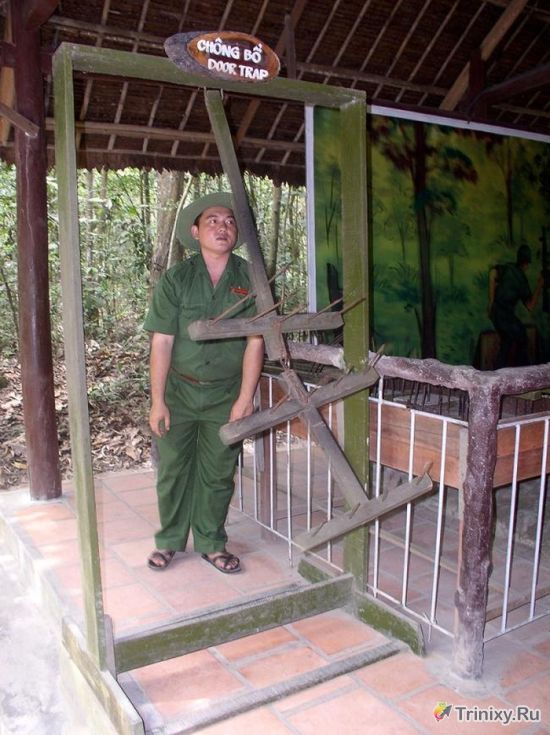
Poisonous snakes - a “gift” to Americans from Vietnamese soldiers
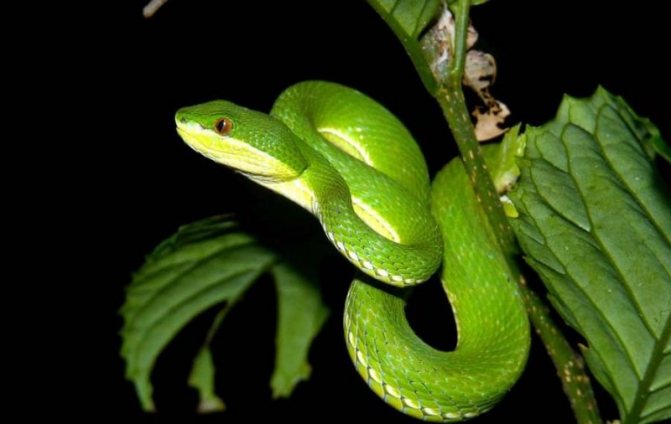
Right at face level During the Vietnam War, soldiers of the National Liberation Front of South Vietnam often used traps, the main damaging elements of which were poisonous snakes.
A small snake called a bamboo keffiyeh, when attacking a victim, releases a hemotoxic poison that disrupts the blood clotting process and destroys red blood cells, organs and tissues. In Asia, it is called the three-step snake, because after being bitten by a bamboo keffiyeh, you will not go far. Her poison acts almost instantly.
The Vietnamese managed to hide bamboo keffiyeh almost everywhere: in bags, boxes, boxes, tunnels. They put them in empty bamboo stalks and left them where the Americans would pass.
This is interesting: The worst thing is that the Vietnamese soldiers hung them on tree branches so that the head of the keffiyeh was at face level. After hanging in this state without food for several days, the snake then attacked everyone who was nearby. Dozens of American soldiers became their victims.

